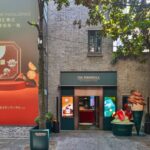
Yuyuan Garden, the oldest garden in Shanghai, is a shining pearl among China’s classical gardens. Built during the Ming Dynasty’s Jiajing period, the garden is filled with artificial mountains, ponds, pavilions, and towers, all nestled among the trees.
Although not grand in scale, its intricate design, delicate layout, and tranquil beauty exemplify the “seeing the big in the small” characteristic, reflecting the artistic style of Jiangnan garden architecture.
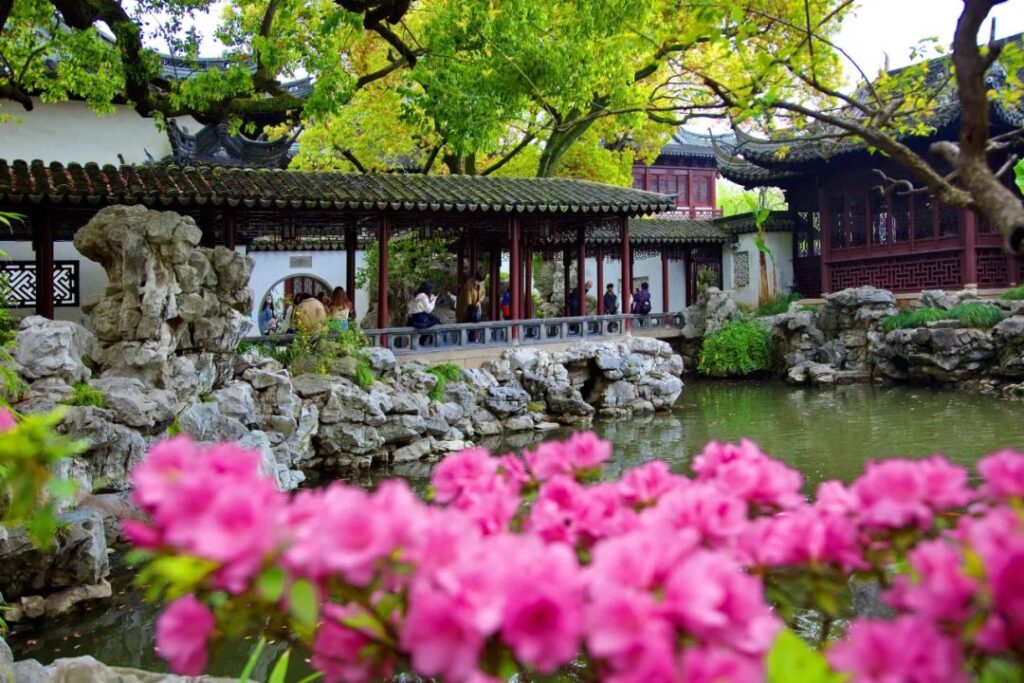
In the 38th year of the Jiajing reign, Pan Yunduan, the son of Pan En, the Minister of Justice, built a residence on a vegetable field in the northwest corner of the City God Temple in Shanghai after failing the ceremonial examination of the Ministry of Rites as a “Juren.” Later, Pan Yunduan was appointed to an official post in another location and had no time to attend to the construction of the garden.
It wasn’t until the fifth year of the Wanli reign, when he returned home after being dismissed from his position as the Sichuan Provincial Administration Commissioner, that he resumed the garden project. After more than twenty years of painstaking construction, Yuyuan Garden was finally completed.
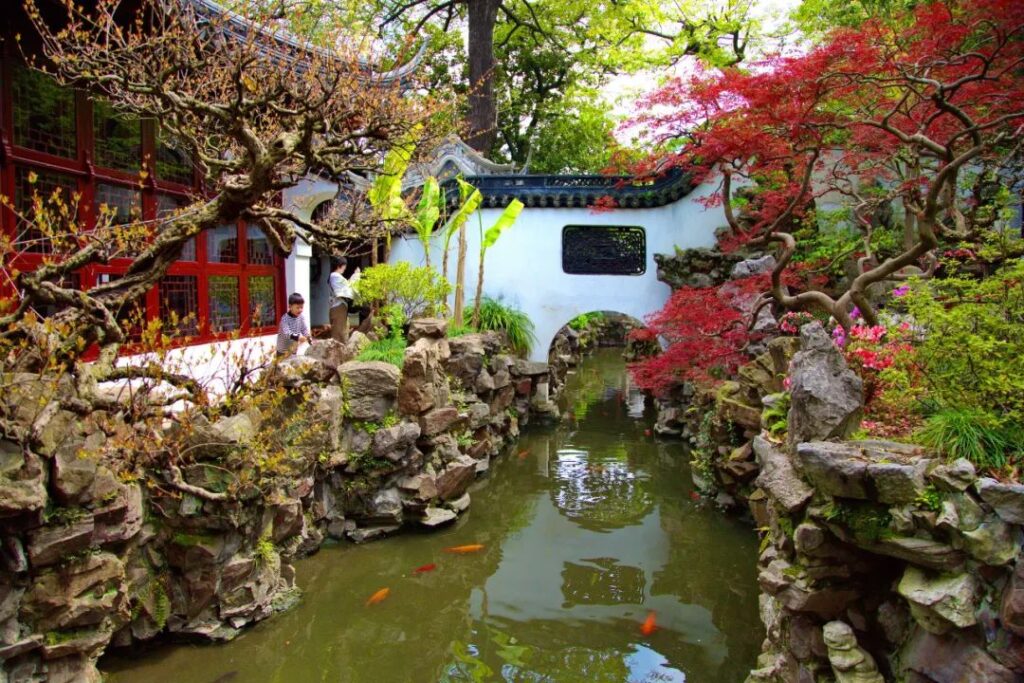
During the middle and late Ming Dynasty, private gardens in Shanghai numbered in the thousands, as it was a flourishing period for garden construction in Jiangnan.
Yuyuan Garden was filled with pavilions, winding paths, and corridors, with strange peaks and rocks standing tall, and ponds, streams, flowers, and ancient trees intertwined, creating a charming scenery. Its landscape, layout, and scale were comparable to the Humble Administrator’s Garden in Suzhou and the Yanshan Garden in Taicang, and it was recognized as the “crown of famous gardens in the southeast.”
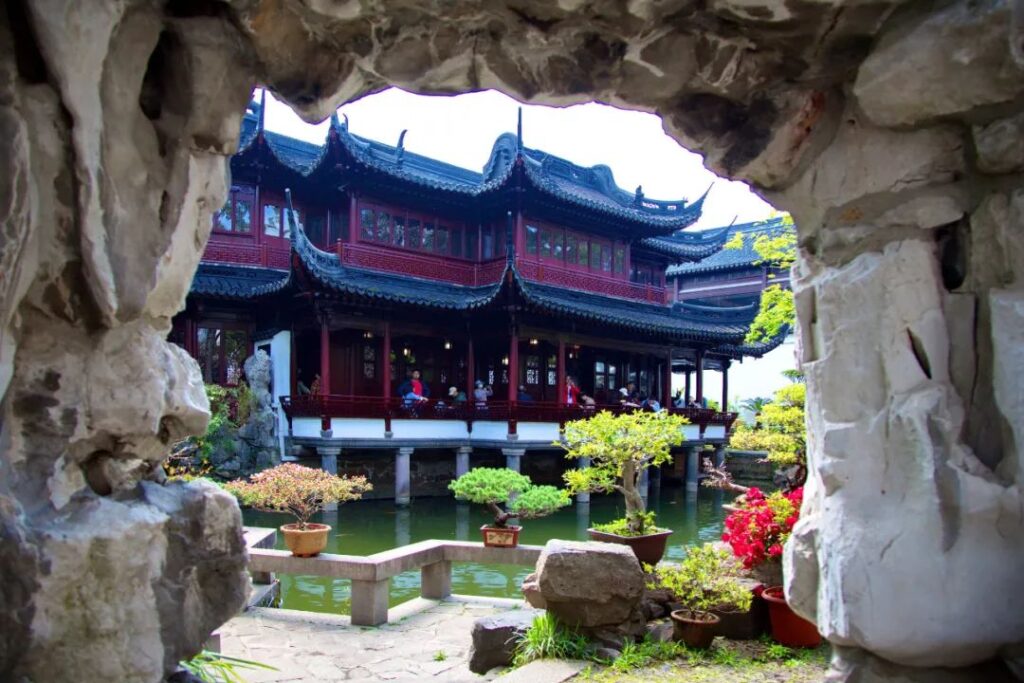
n the first Chinese dictionary, “Erya,” the word “yu” is explained as “joy,” and in Pan Yunduan’s “Yuyuan Ji,” he also noted that “Yuyuan, means to please the elderly parents.”
From this, it can be seen that Pan Yunduan built the garden for his parents to spend their later years in, but due to the prolonged construction, Pan En passed away just as Yuyuan Garden was completed, and it actually became a place for Pan Yunduan himself to retire and enjoy.

Yuyuan Garden is a garden that has experienced many disasters. It suffered the ravages of the British army during the First Opium War and the destruction by the Qing troops after the failure of the Small Swords Society Uprising.
Later, the British and French invaders dug up rocks and filled in ponds in the garden to build barracks, completely changing the appearance of the garden.
During the Guangxu period of the Qing Dynasty, the entire garden was divided by more than twenty trade associations in Shanghai, further obliterating the original garden landscape.
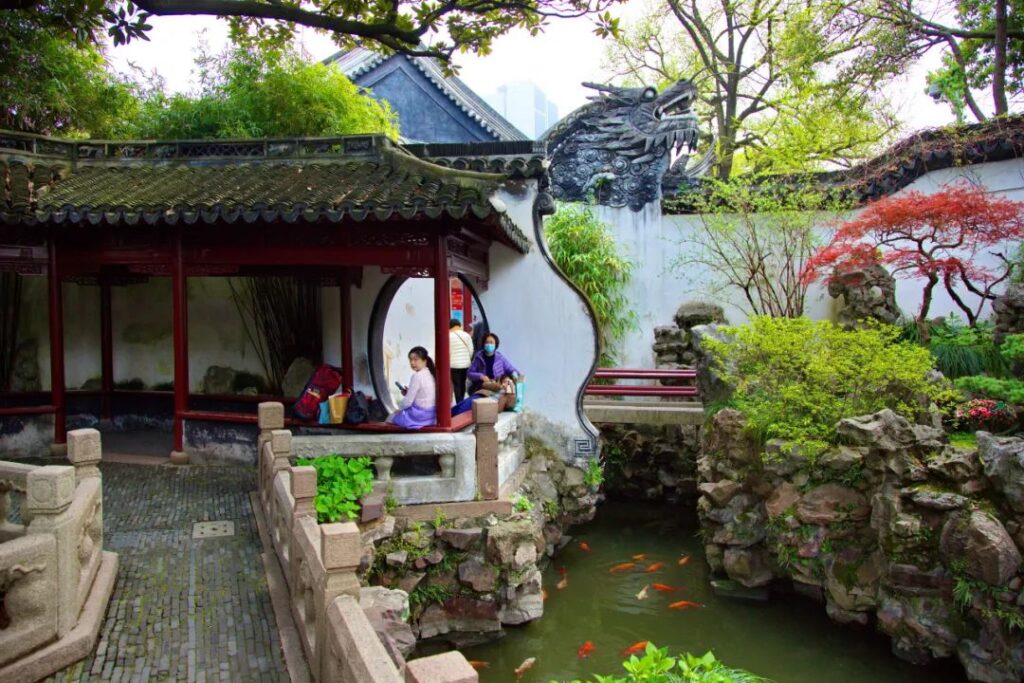
After the founding of New China, Yuyuan Garden underwent several large-scale reconstructions, including demolishing buildings, restoring the garden, digging ponds, and piling rocks.
Through site excavations, archaeological research, and tracing the origins of numerous historical documents about Yuyuan Garden, many historical sites in the garden were revived, and the relatively complete appearance of Yuyuan Garden was restored.
The revival of Yuyuan Garden also became a reenactment of the construction process of traditional literati gardens.
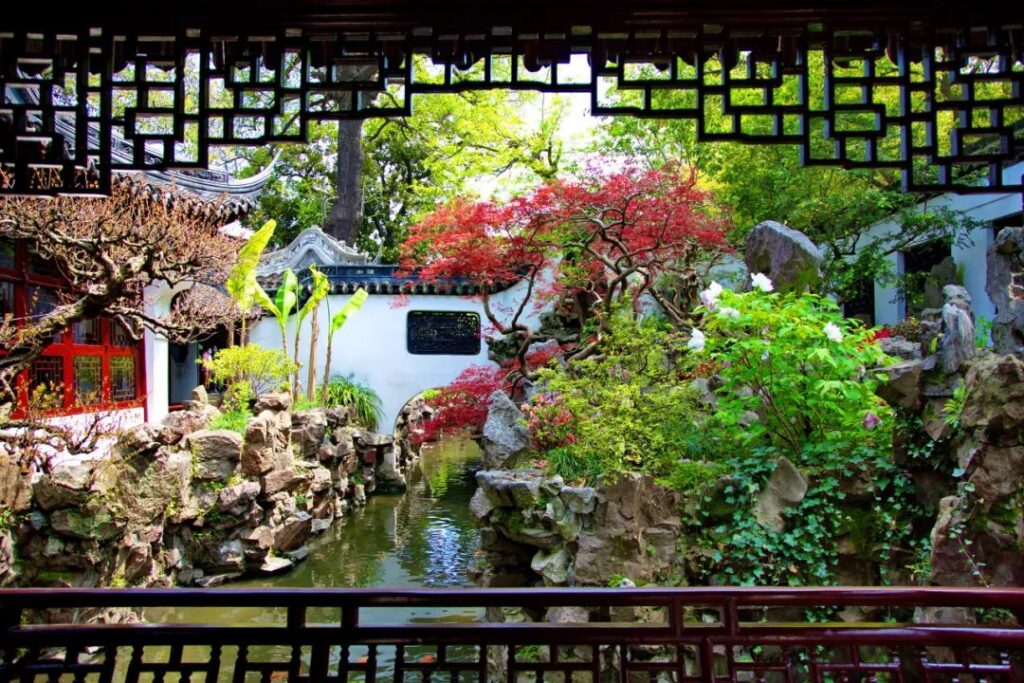
Upon entering Yuyuan Garden, you will discover that every corner of the garden is a beautiful scene.
Artificial mountains, small ponds, winding paths, pavilions, and towers, one after another, make it hard to take in all the beauty at once.
As a famous garden in Jiangnan, although Yuyuan Garden was also a private residence of a wealthy family, the not-so-large garden is still divided into six scenic areas: Sansui Hall, Wanhua Tower, Dianchun Hall, Huijing Tower, Yuhua Hall, and the Inner Garden.
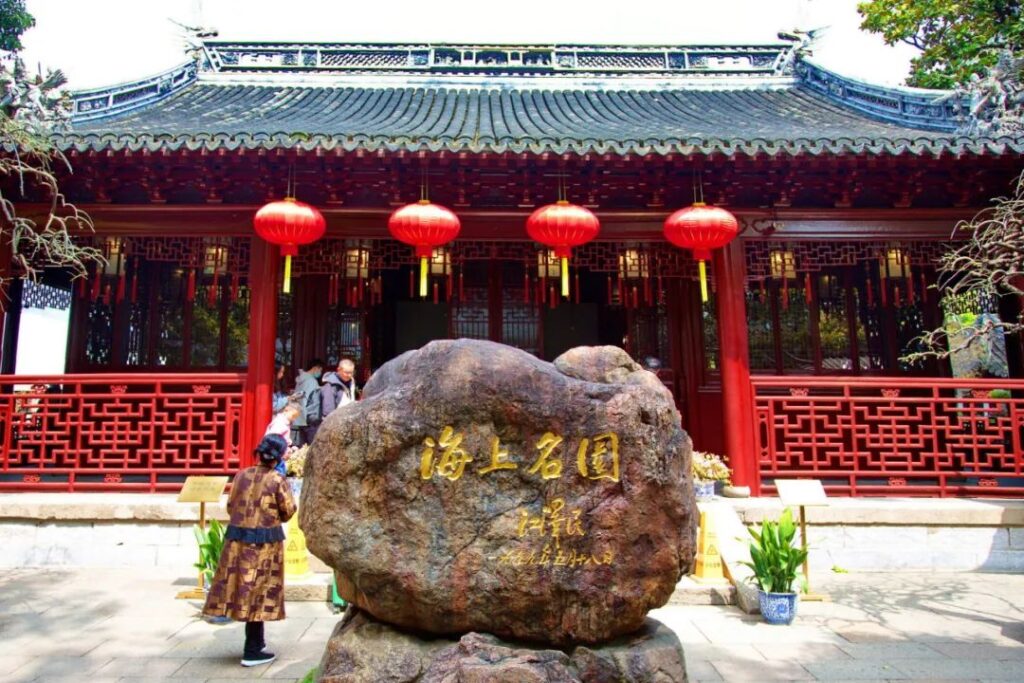
Entering through the main gate by the Nine-Bend Bridge, you will first arrive at the Sansui Hall scenic area. “Sansui Hall” is one of the main buildings in Yuyuan Garden.
The term “Sansui” comes from the story of “three ears of grain on the beam” in the “Book of the Later Han,” symbolizing auspiciousness.
During the Qing Dynasty, this was where the Bean and Rice Trade Association held meetings and set standard measures, hence it was also called the “Jiao Hu Hall.”
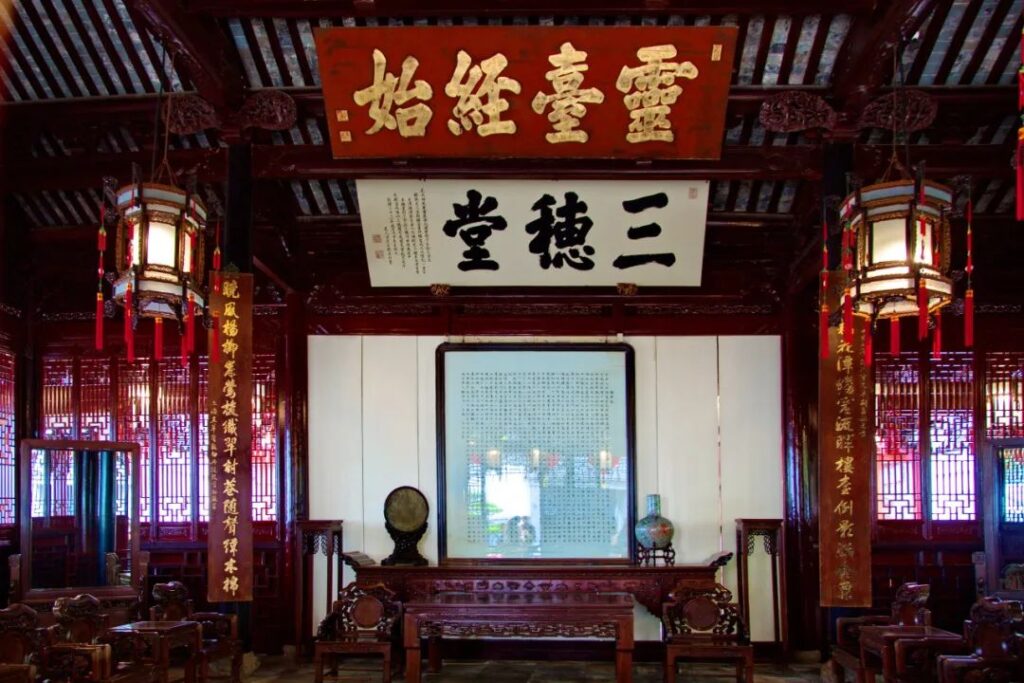
Upon entering the hall, you can see that the four sides of the hall are surrounded by corridor windows. In the center of the hall, there is a giant mirror frame containing the “Yuyuan Ji” written by the garden owner Pan Yunduan and calligraphed by the modern calligrapher Pan Boying.
On the table in the hall, there is a vase and a mirror, symbolizing “peace and tranquility.” Under the illumination of the palace lanterns on the beams, the entire hall gives a sense of serenity, solemnity, and elegance.
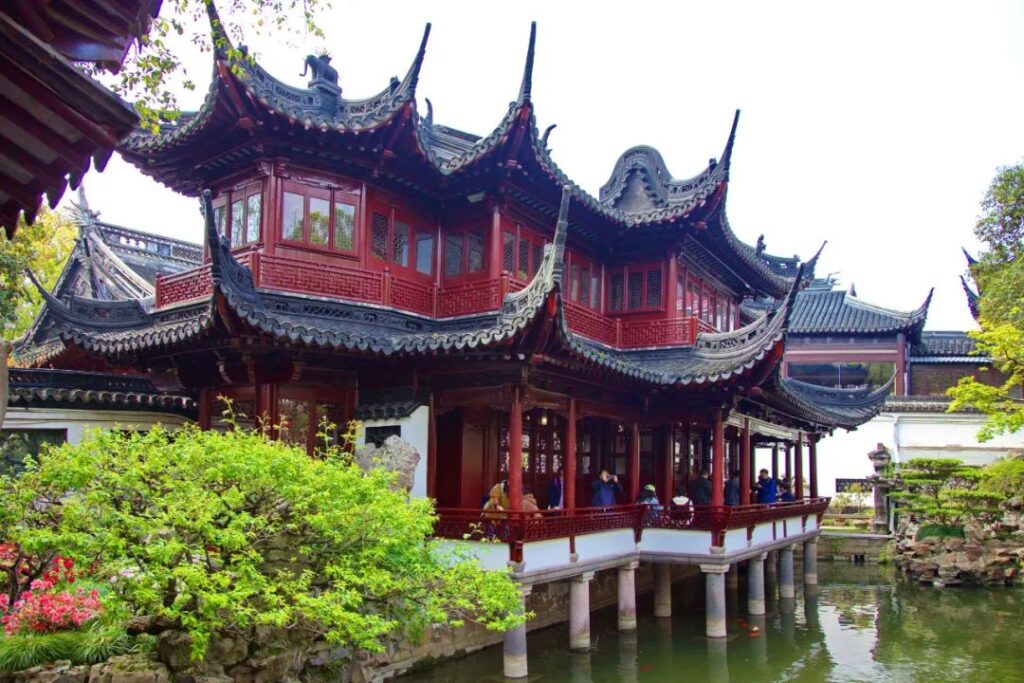
Behind Sansui Hall, there is a two-story building, with “Yangshan Hall” on the lower floor and “Juanyu Tower” on the upper floor.
The name “Juanyu Tower” is derived from the line “The pearl curtain rolls up the rain from the western mountains in the evening” in the poem “Tengwang Pavilion” by the Tang Dynasty poet Wang Bo.
On the north side of Yangshan Hall, there is a corridor with curved railings overlooking the pond, where visitors can rest. Sitting in the corridor, one can lean on the railing and admire the large artificial mountain across the pond.

The “Large Artificial Mountain” faces Yangshan Hall across the water and is the oldest, most exquisite, and largest yellow stone artificial mountain in Jiangnan.
The artificial mountain was designed and built by Zhang Nanyang, a famous rock-stacking master of the Ming Dynasty.
The Large Artificial Mountain is composed of thousands of tons of Wukang yellow stones, with undulating peaks, winding paths, deep gullies and ravines, and clear springs flowing like a stream.
The mountain is lush with flowers and trees, and surrounded by a pool of water at its base. Climbing the mountain gives the impression of being in a mountain range.
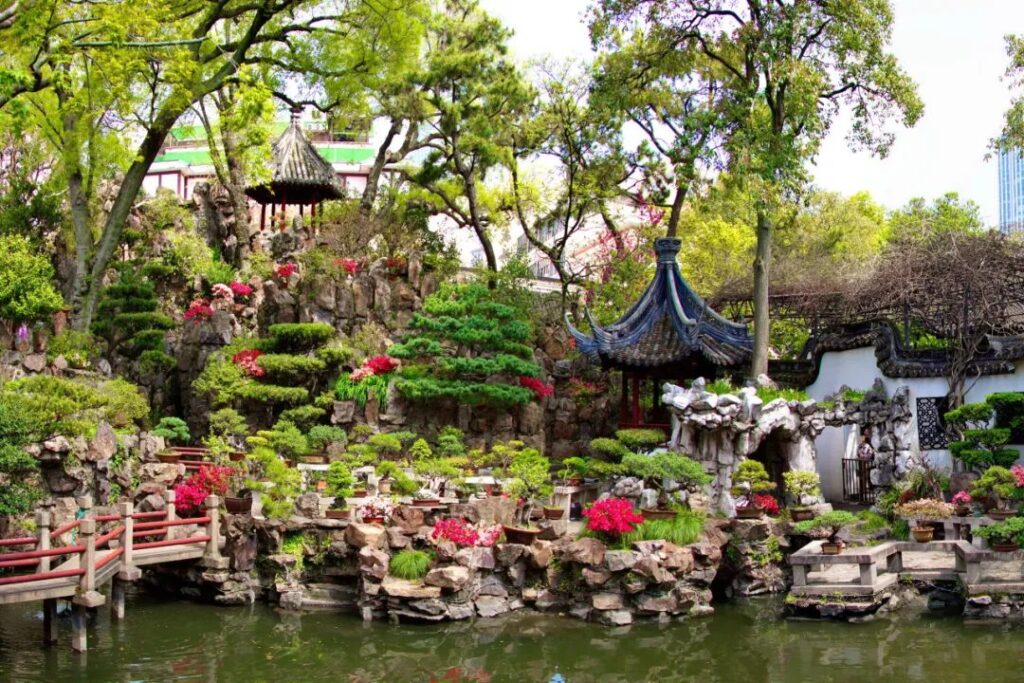
There are two pavilions built on the Large Artificial Mountain. One is called “Yixiu Pavilion,” meaning that one can appreciate the beautiful scenery of the garden from this pavilion. The other is called “Wangjiang Pavilion,” implying that one can see the dotted sails on the Huangpu River from the pavilion.
Although Yuyuan Garden has undergone several periods of decline since its construction, the Large Artificial Mountain has maintained its old appearance. In “Yuyuan Ji,” the garden owner Pan Yunduan boasted about the Large Artificial Mountain, saying, “The steep and beautiful mountains are quite pleasing to the eye.”
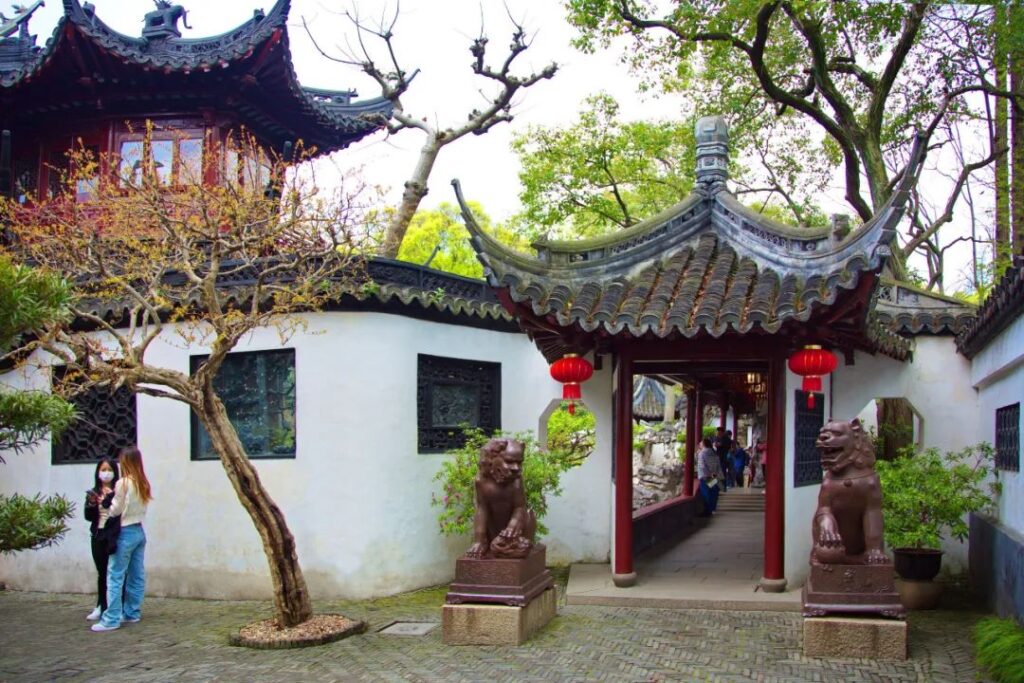
In front of the “Gradually Entering the Wonderful Scenery” corridor east of Yangshan Hall, there is a pair of exquisitely cast and lively iron lions.
The iron lions were cast in 1290, and the base bears the inscription “Zhao Zhang, a craftsman from Tongshan Town, Anyang County, Zhangde Prefecture.” Entering the corridor, there is a small bridge with beauty railings on both sides where one can sit and enjoy the mountain scenery and water views.
In the corridor, there is a Taihu stone that resembles a beautiful woman’s slender waist and glancing pose, named “Beauty’s Waist.”
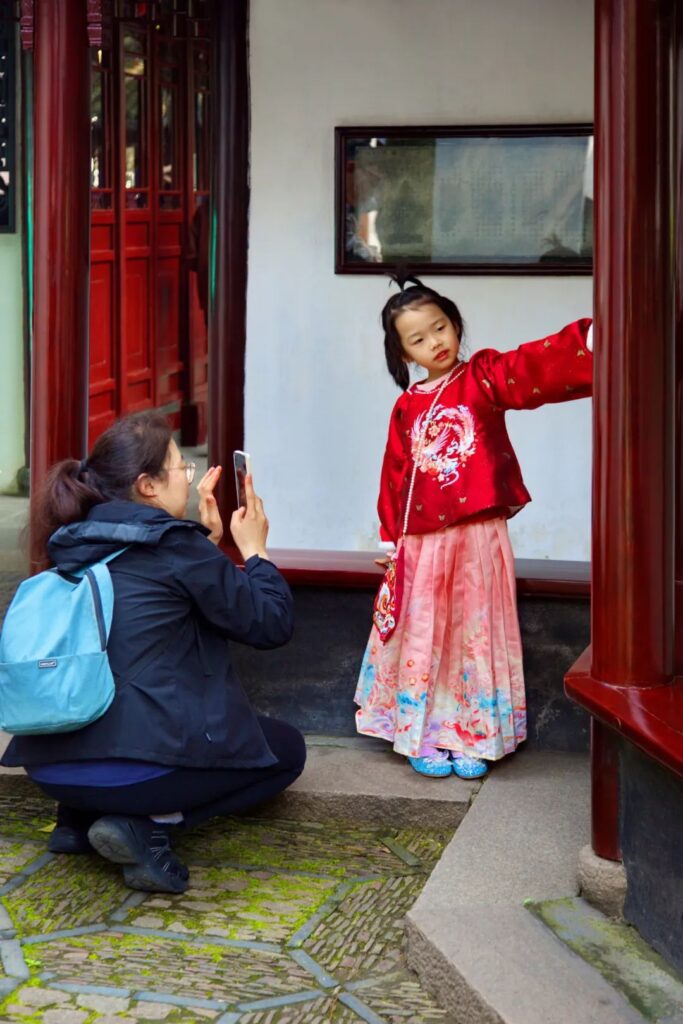
Following the corridor to the “Winding Paths” section and turning right through the “Meeting of Hearts is Not Far” pavilion, one enters the compound corridor and arrives at the Wanhua Tower scenic area of Yuyuan Garden.
The winding compound corridor is separated by a white wall with lattice windows, and both sides of the wall are walkable. Here, the compound corridor serves as both a passageway and a scenic frame, capable of dividing the scenic area, increasing the depth of the scenery, enhancing penetration, and brewing surprises.
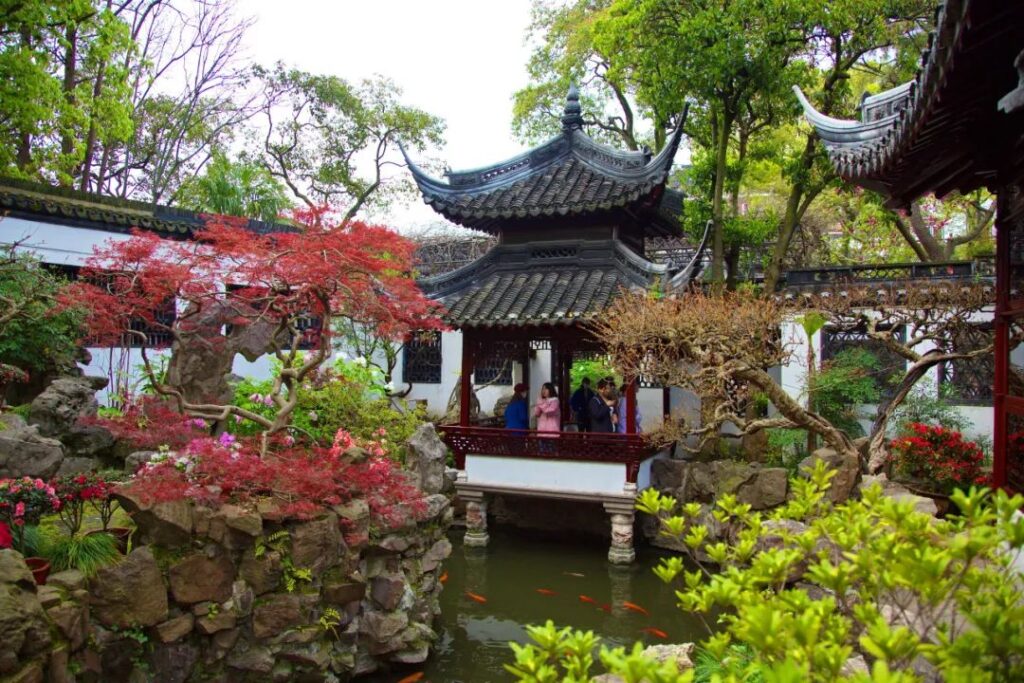
Entering the Wanhua Tower scenic area and turning right, the “Yule Pavilion” is perched above a small stream, and its name is derived from the allusion of “the debate between the ditch and the beam.”
Zhuangzi said, “The fish are swimming freely and leisurely, which is the joy of the fish.” Huizi said, “You are not a fish, how do you know the joy of the fish?” Zhuangzi replied, “You are not me, how do you know that I don’t know the joy of the fish!” Leaning on the railing and observing the fish, one naturally understands the meaning behind the small pavilion’s name, “Yule.”
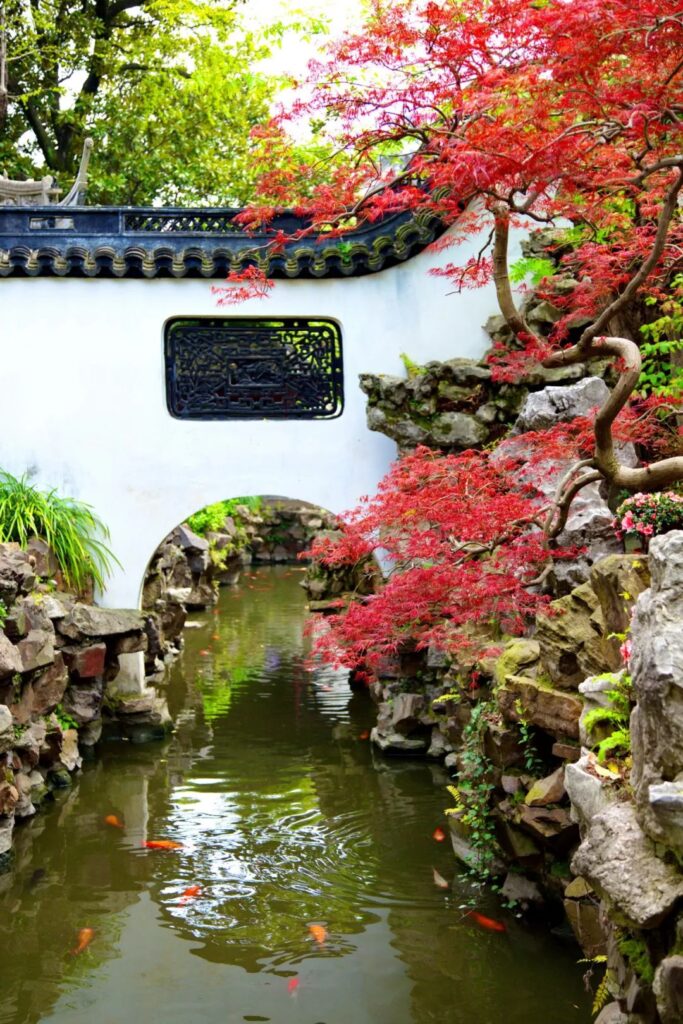
Sitting in the pavilion, one can see a flower wall built across the small stream in front of the pavilion, with lattice windows on the wall and a semi-circular arched door at the bottom of the wall.
The water flows through the arched door, and this scene can’t help but make one imagine “where the small stream goes.” This garden-building technique is precisely the method of extending space in Chinese gardens, dividing the limited space into real and virtual to create an artistic realm of infinite space.
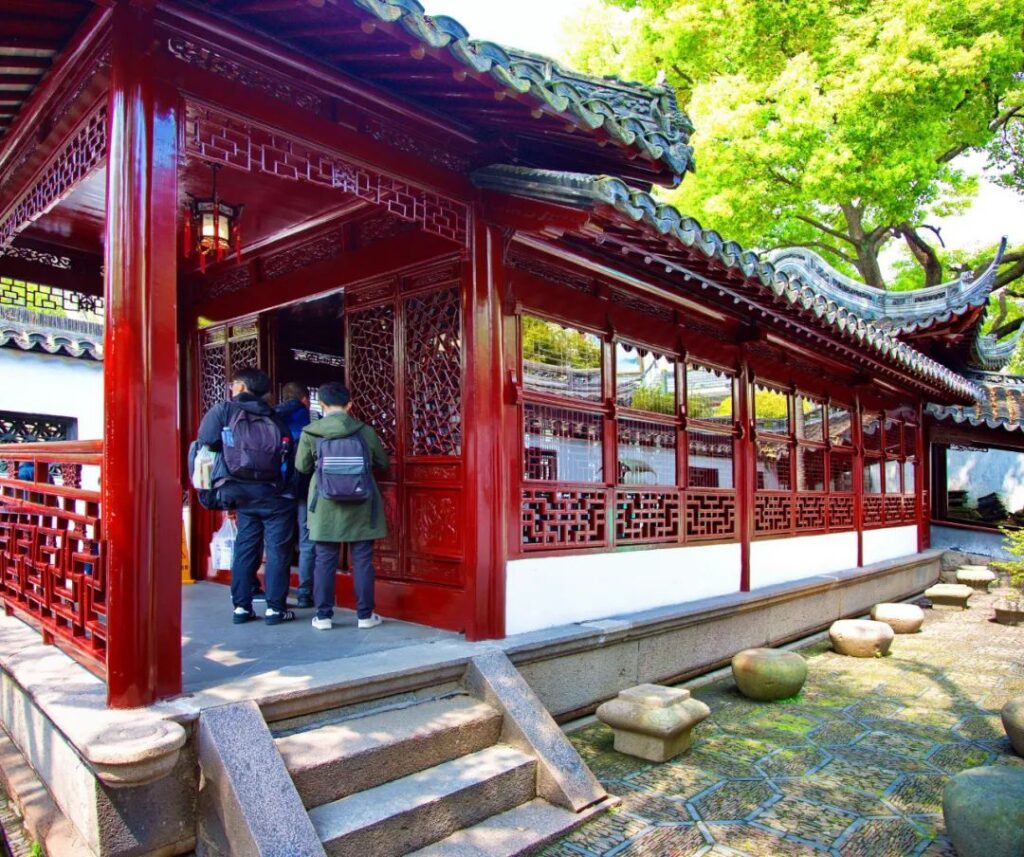
On the north side of the compound corridor, there is a building shaped like an ancient boat, named “Yifang.” In Jiangnan garden architecture, boat buildings are mostly built by the water for enjoying the moon or cooling off by the water.
However, it is rare to directly construct a boat on land. It is said that this boat was added later, and its interior layout is similar to other boats in Jiangnan.
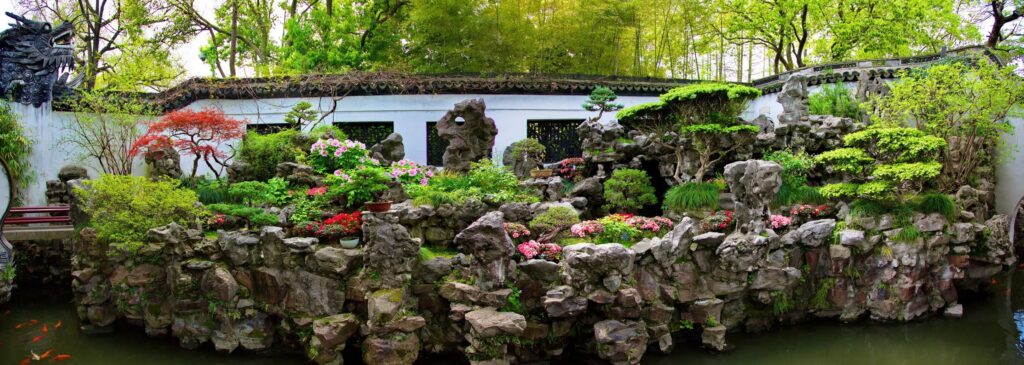
To the south of the eastern end of the compound corridor is the “Liangyi Pavilion,” named after the meaning of “both appreciating the mountains and the water.” Sitting inside the pavilion, the natural scenery is all within sight.
Leaning forward and looking down, one can see the clear stream water, and across the stream, one can see the stone mountain piled under the pink wall. Among the mountain rocks, there are orchids, winter jasmines, boxwoods, magpies, bamboos, and peonies, highlighting the meaning of “ten thousand flowers” in the scenic area.
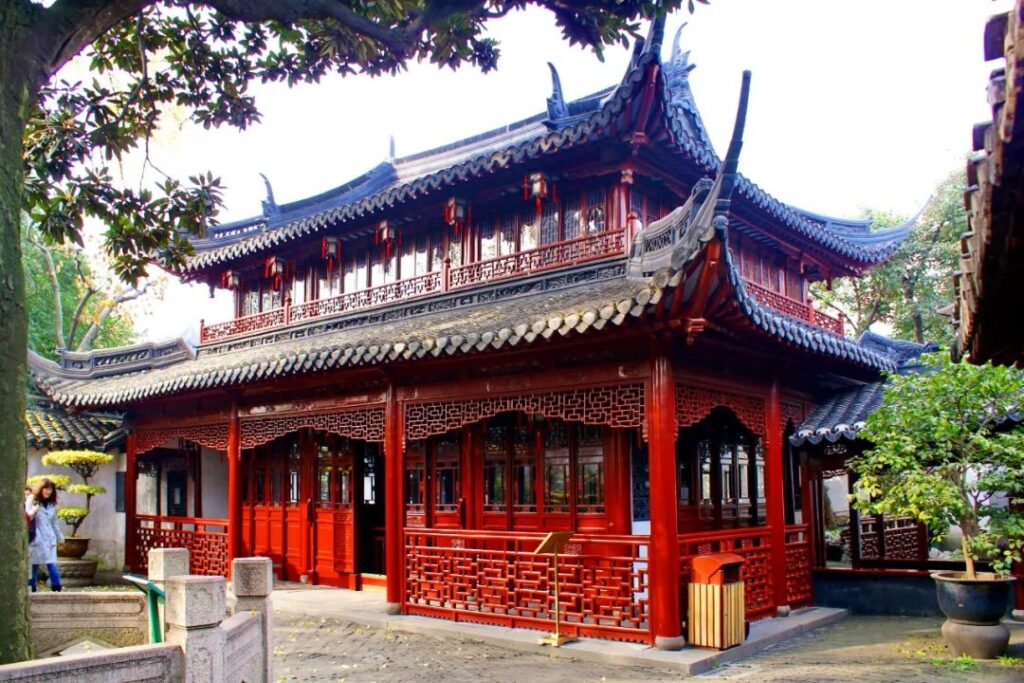
The original site of “Wanhua Tower” was the ruins of the Flower God Pavilion from the Ming Dynasty. During the Daoguang period of the Qing Dynasty, the Flower God Pavilion was rebuilt.
At the end of the Qing Dynasty, the small statue of the City God was enshrined in the tower, and it was named “Shenchi Hall” because the gods and humans were only a short distance apart.
After the founding of the People’s Republic of China, it was renamed Wanhua Tower. Wanhua Tower is a two-story building with corridor windows on all sides and curved corridors connecting the two sides.
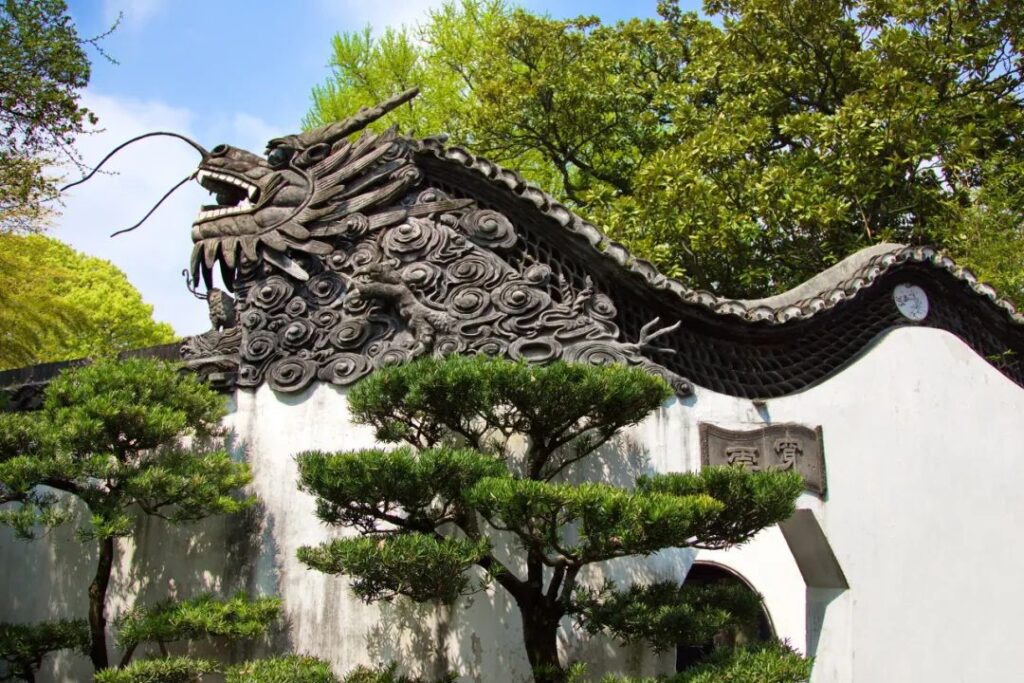
Walking east from Wanhua Tower, passing through the moon gate of the dragon wall, one enters the Dianchun Hall scenic area. The Chuanyun Dragon Wall is an eye-catching sight in Yuyuan Garden.
On the high wall ridge, tiles are used as scales to form the dragon’s body, and the corners of the wall are sculpted with dragon heads and cloud patterns using clay. There are a total of five dragons on the dragon walls of Yuyuan Garden: the reclining dragon behind the Large Artificial Mountain, the two dragons playing with a pearl west of Hexu Hall, and the sleeping dragon that can be observed in the Inner Garden.
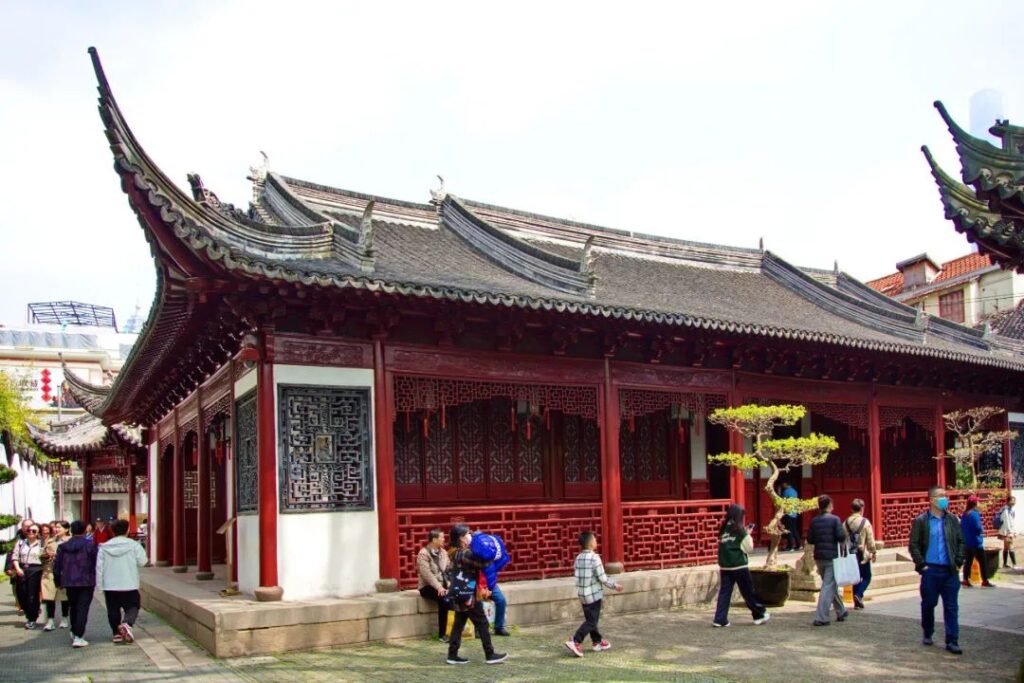
“Dianchun Hall” was built in the early years of the Daoguang period of the Qing Dynasty and was once a place where Fujian-based flower candy and foreign goods merchants worshipped gods and discussed business. It was commonly known as the “Flower Candy Mansion.”
The name Dianchun Hall is derived from the phrase “the green dots the spring beauty” in the poem “Qi Shi” by the Song Dynasty poet Su Shi. During the Ming and Qing Dynasties, literati and gentlemen watched plays in Dianchun Hall and selected actors and plays according to their preferences, so “Dianchun” also has this meaning.

During the Qing Dynasty, the famous Small Swords Society Uprising broke out in Shanghai, and Dianchun Hall was the northern command center of the Small Swords Society at that time.
The leaders of the Small Swords Society worked here, issuing political orders, and this place was called the “Dianchun Hall Mansion.”
After the failure of the uprising, Dianchun Hall was severely damaged. In the seventh year of the Tongzhi period of the Qing Dynasty, funds were raised to repair it, and Dianchun Hall is the only remaining site of the Small Swords Society Uprising.
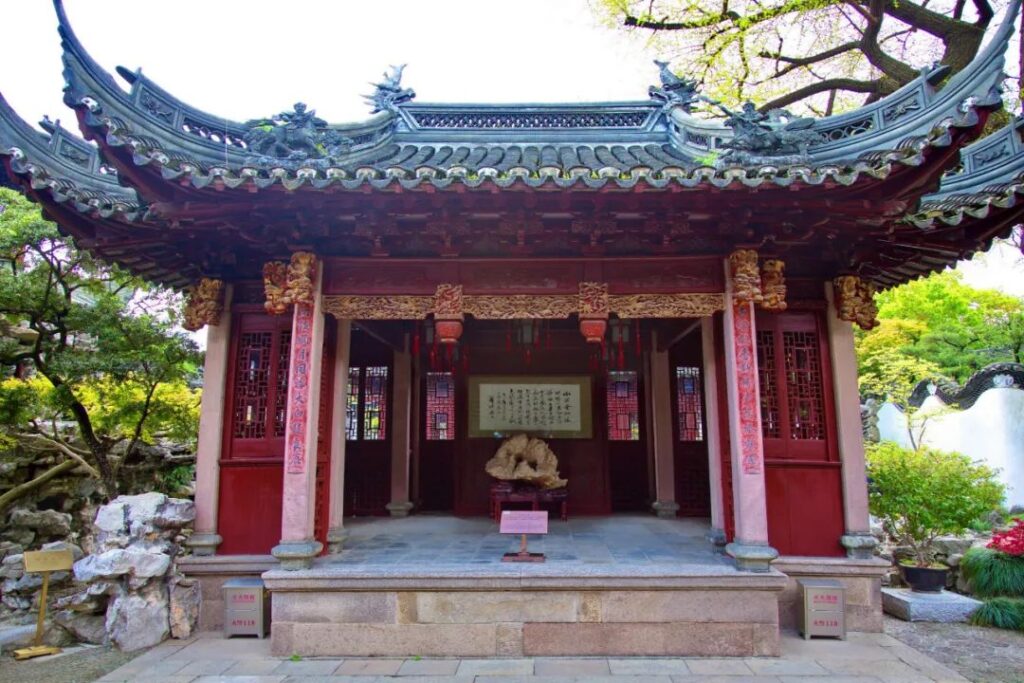
“Dachang Stage” is a small stone-structured opera stage opposite Dianchun Hall, also known as “Fengwu Luanyin.” The stage is built against the mountain and by the water, half-spanning the water. The eaves in front of the stage are intricately carved and painted with gold and colors.
On the stone columns on the four sides of the stage, there are couplets describing the scenery of the four seasons: spring, summer, autumn, and winter. On the central wall of the Dachang Stage, there is a poem written by Guo Moruo when he visited Yuyuan Garden in 1961.
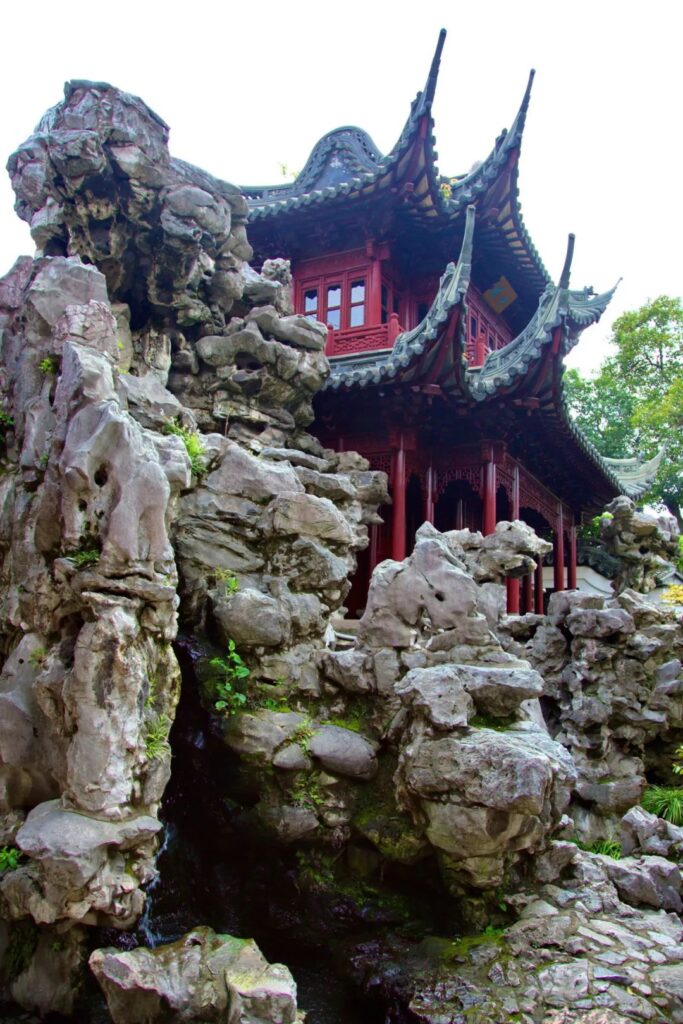
“Baoyun Rock” is a Duoyun-shaped lake stone artificial mountain southeast of Dianchun Hall. The mountain shape is exquisite and transparent, with winding water and stones, and deep valleys and caves.
On top of the artificial mountain, there is a two-story pavilion, with the upper level called “Kuai Lou” and the lower level called “Yanshuang Ge,” showcasing the beauty of Jiangnan garden architecture. Descending south from Kuai Lou, there are also Jingyi Xuan and Tingli Pavilion, surrounded by flower walls, forming a small courtyard.

“Hexu Hall” is located south of the Dachang Stage, facing the stage across the water. Hexu Hall faces the mountain and has its back to the water, open on all four sides, cool in summer and warm in winter, hence its name “Hexu Hall.” Hexu means gentle sunlight, referring to the spring sunlight. In this way,
Dianchun Hall and Hexu Hall harmoniously blend in their names, highlighting the “spring” theme of this courtyard.
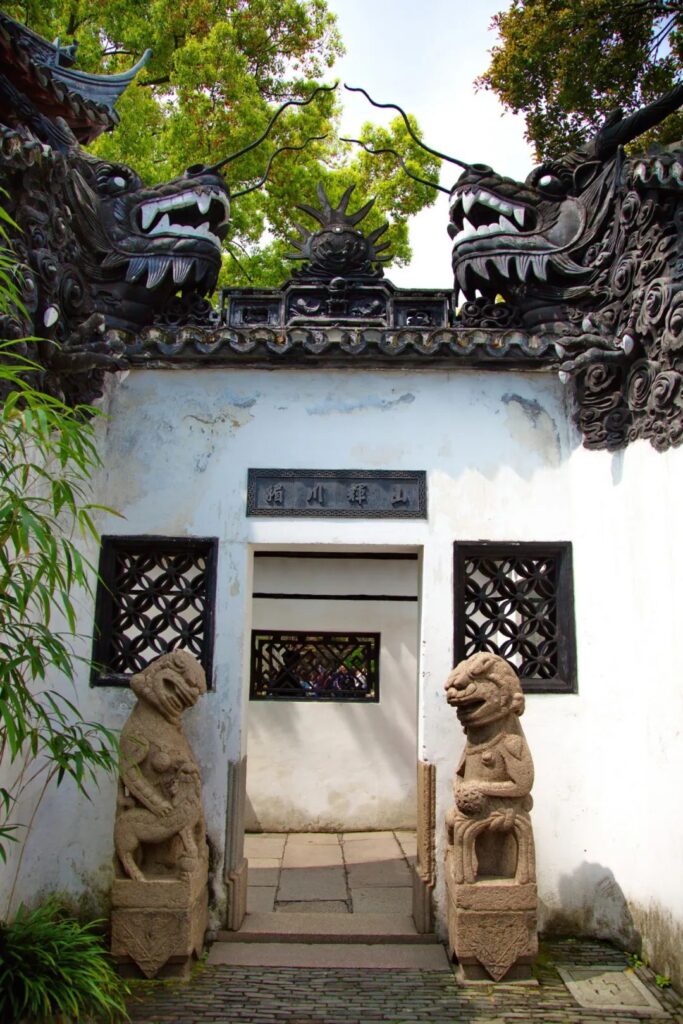
In the southwest corner of Hexu Hall, there is a covered walkway leading to the Huijing Lou scenic area. The lintel of the walkway’s arched gate bears the inscription “Shan Hui Chuan Mei,” taken from Lu Ji’s “Wen Fu” of the Jin Dynasty: “The stone conceals jade and produces radiance, the water embraces pearls and the river is charming,” describing the extremely beautiful scenery.
Above the ridge of the arched gate, two giant dragons face each other, with a sculpted pearl in the middle, which is the famous “Two Dragons Playing with a Pearl” in Yuyuan Garden.
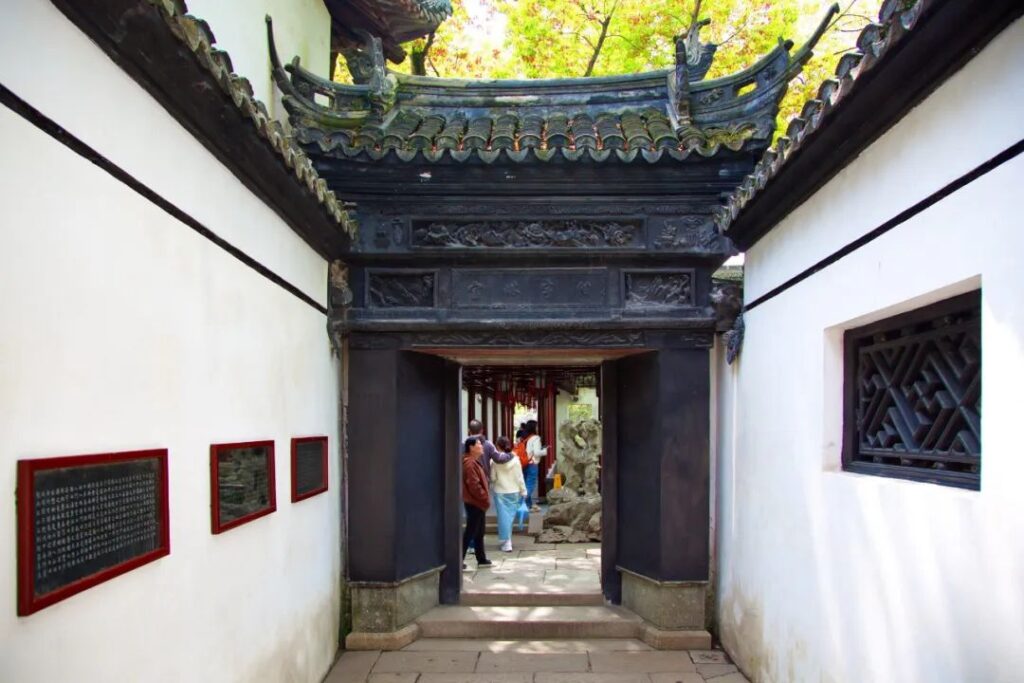
Passing through the “Two Dragons Playing with a Pearl” dragon gate and along the narrow covered walkway through two arched gates, a vast water landscape comes into view, making one feel suddenly refreshed.
This is the Huijing Lou scenic area in the center of Yuyuan Garden. The Huijing Lou scenic area is the central area of Yuyuan Garden and the most spacious place in the garden. The scenic area is dominated by water landscapes, with pleasant scenery and unique features.

Walking through the walkway gate and turning left, one reaches the Laojun Hall in Yuyuan Garden.
It is said that after the garden owner Pan Yunduan passed away, the Pan family’s fortune declined and they sold the garden. During the Qing Dynasty’s Qianlong era, in order to build the City God Temple garden, Shanghai gentry gathered funds to purchase Yuyuan Garden, rebuilding the buildings and adding mountains and rocks.
Laojun Hall was the hall where the City God Temple worshipped the Supreme Lord Lao at that time.
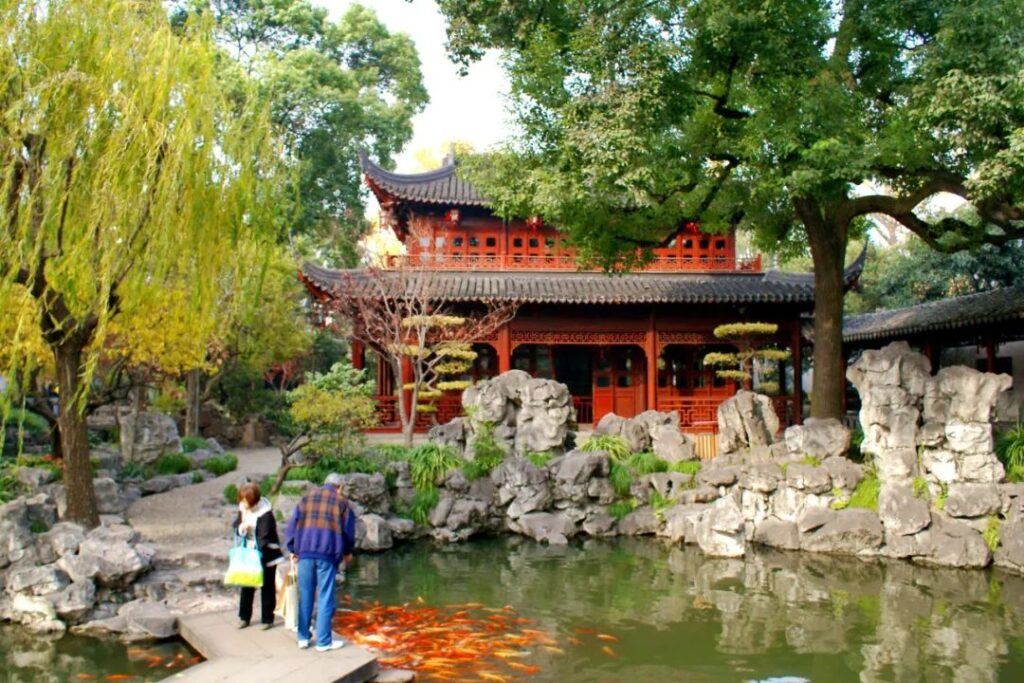
“Huijing Lou” was built in the ninth year of the Tongzhi reign of the Qing Dynasty. It is located in the center of Yuyuan Garden.
Climbing to the top of the building, one can take in the entire garden’s scenery. Huijing Lou consists of two levels of pavilions, with Dunhou Hall on the lower level and Huijing Lou on the upper level.
The building is surrounded by trees such as camphor, pomegranate, crape myrtle, red maple, and podocarpus, creating a pleasant environment.
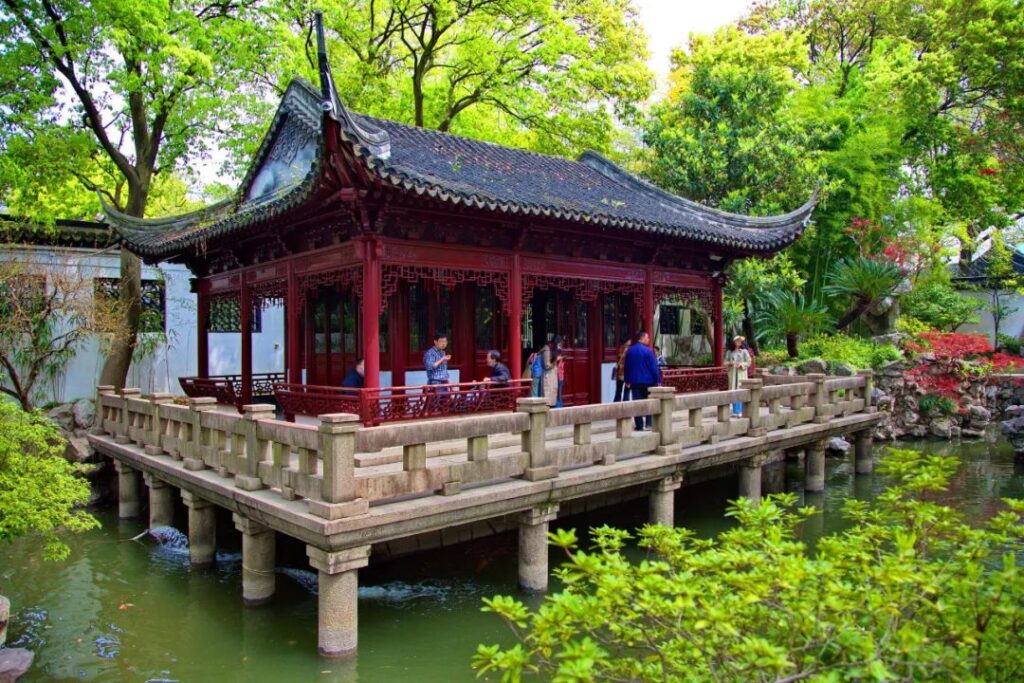
“Jiushi Xuan” is an open-style building facing the large pond. The moon terrace in front of the pavilion is a great place to watch fish and enjoy flowers, where one can lean on the railing and admire the garden’s beauty.
To the west of the pavilion is a patch of bald cypress trees, tall and straight. To the east of the pavilion are thousands of bamboo stalks, a sea of green. Jiushi Xuan was built in 1959 during the renovation of Yuyuan Garden.
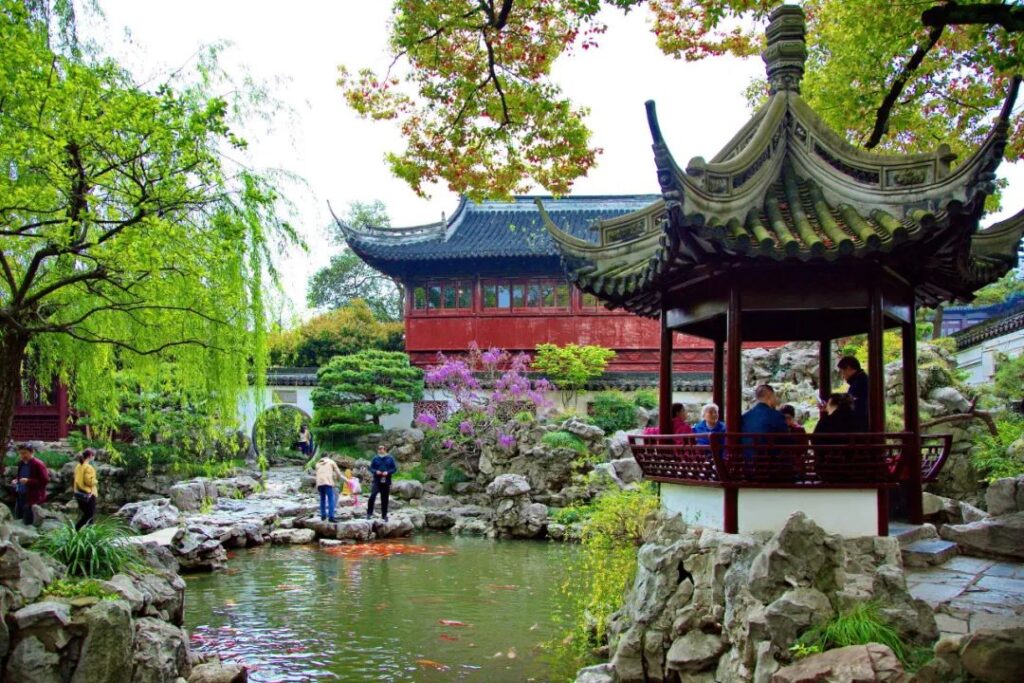
South of Huijing Lou is a large pond, where the scenery includes many elements of Jiangnan garden pavilions, bridges, and flowing water, making it endlessly beautiful and captivating.
The “Liushang Pavilion” on the west side of the pond is named after the phrase “flowing wine and winding water” from the “Preface to the Orchid Pavilion” by Wang Xizhi, a calligrapher from the Eastern Jin Dynasty, as the pavilion faces water on two sides.
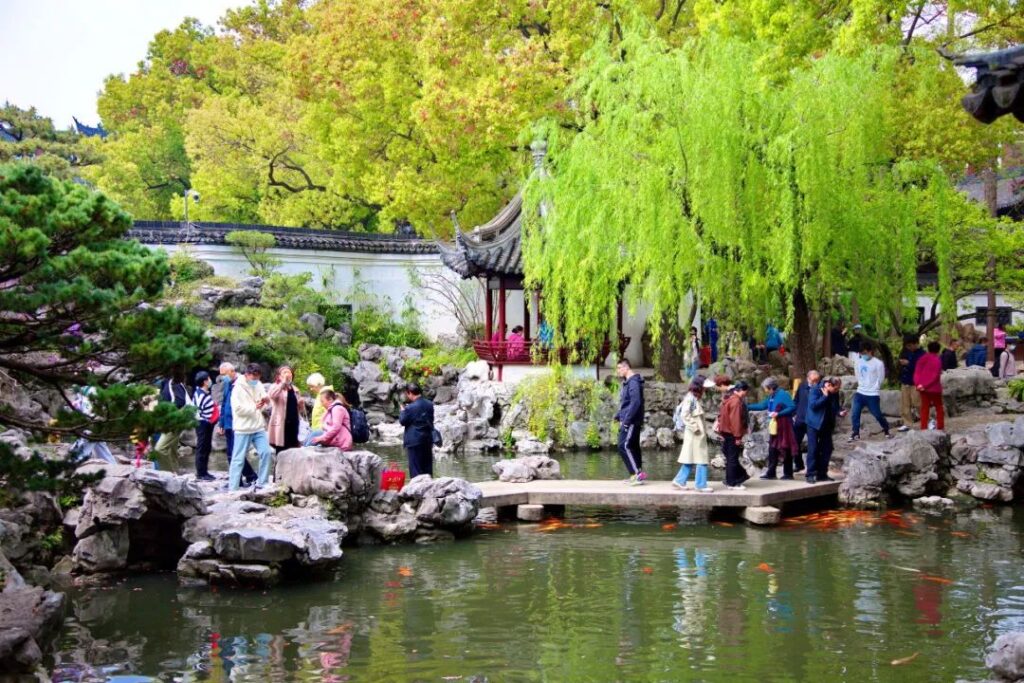
On the east side of Liushang Pavilion, there are flat bridges and corridor bridges. Walking on the bridges, it is like walking on waves and stepping on water. The “Three-Arch Bridge” is built close to the water, winding towards the opposite shore.
The bridge surface is a great place to play with fish. Squatting on the bridge and throwing a handful of feed into the water, the koi gather to compete for the food, and the tranquil pond water suddenly becomes lively.
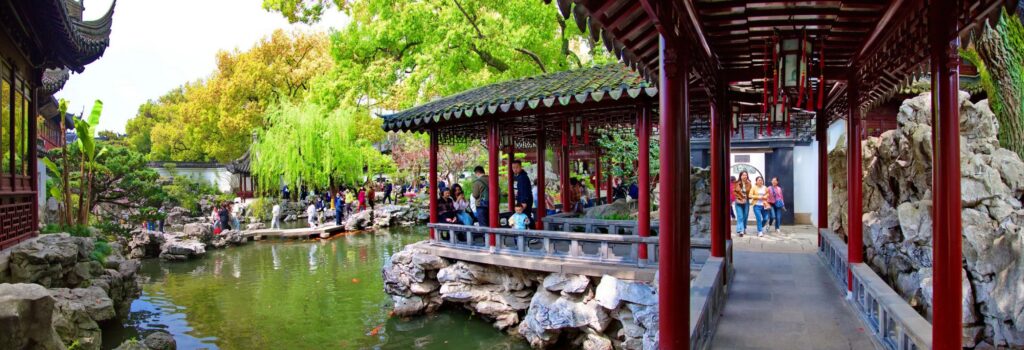
“Jiyu Water Corridor” is a corridor bridge named after a Taihu rock called “Jiyu Peak” next to the bridge. The nearly hundred-meter-long corridor bridge is built on the shore for the first half and on the water for the second half.
It is the longest corridor bridge in classical Jiangnan gardens, reaching Huijing Lou in the north and Hanbi Lou in the south. Strolling along the corridor, the shore is lush and green, red fish swim in the pond, and the pavilions and towers are shimmering with light, full of poetic charm.

“Tingtao Pavilion” is located on the east side of Jiyu Water Corridor, facing Hanbi Lou across the pond to the south. It is a two-story building facing south, with a sculpture of a one-legged crane standing on top of the pavilion. “Tingtao” is derived from the idea that the sound of waves from the nearby Huangpu River can be heard here.
The lower level on the south side of Tingtao Pavilion is a protruding structure supporting the main building, while the upper level is an elegant room. The upper and lower levels on the north side serve as the exhibition hall of Yuyuan Garden.
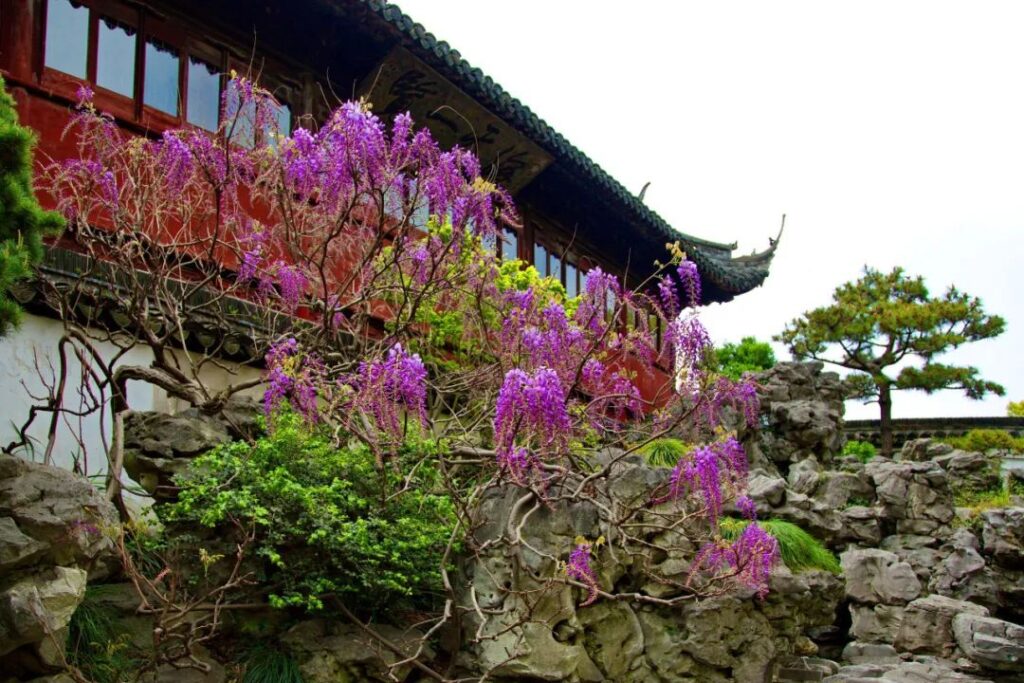
“Huanyun Rockery” is made of lake rocks from Chaohu Lake in Anhui Province. One can reach the top of the mountain by winding through the mountain caves. Huanyun Rockery leans against Deyue Lou to the south and borders a clear pond to the west.
Wisteria vines wind around the mountain, and the reflection of the rockery in the water blends with the floating clouds in the sky, as if washing white clouds in the water and dyeing the rockery in the clouds. The rockery is thus named “Huanyun” (Washing Clouds).
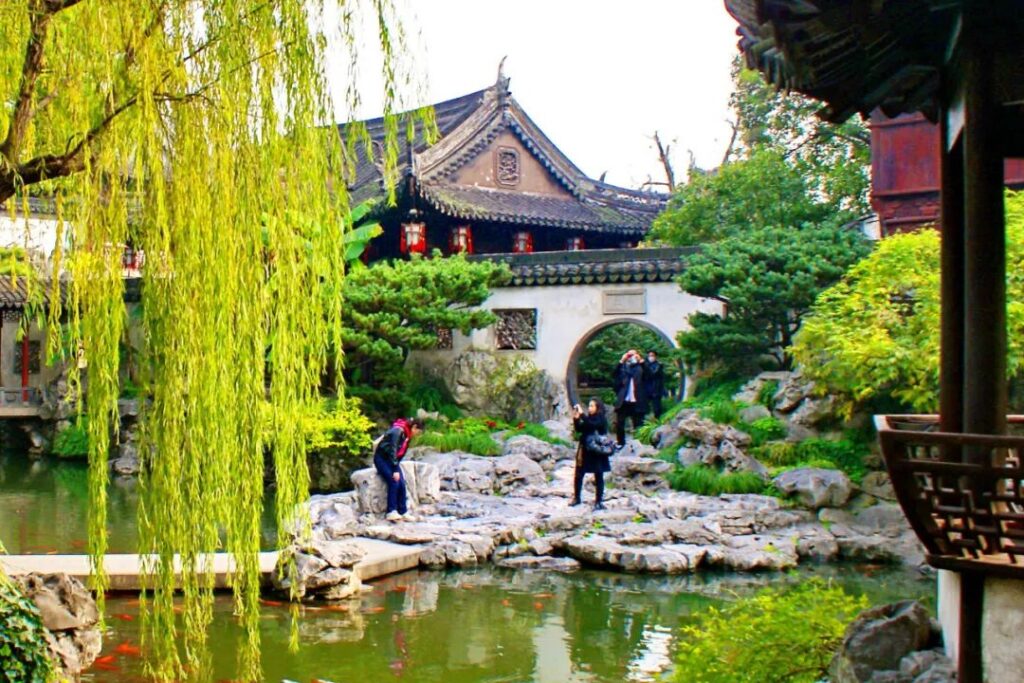
The Three-Arch Bridge connects Huijing Lou in the north and Deyue Lou in the south. Crossing the Three-Arch Bridge and entering the “Yinyu Cave Gate” leads to the Yuhua Hall scenic area of Yuyuan Garden.
“Yinyu” means guiding tourists towards the exquisite jade, and the circular Yinyu Cave Gate is also a highlight of Yuyuan Garden’s scenery. Many people regard it as an iconic spot of Yuyuan Garden and enjoy taking photos here.
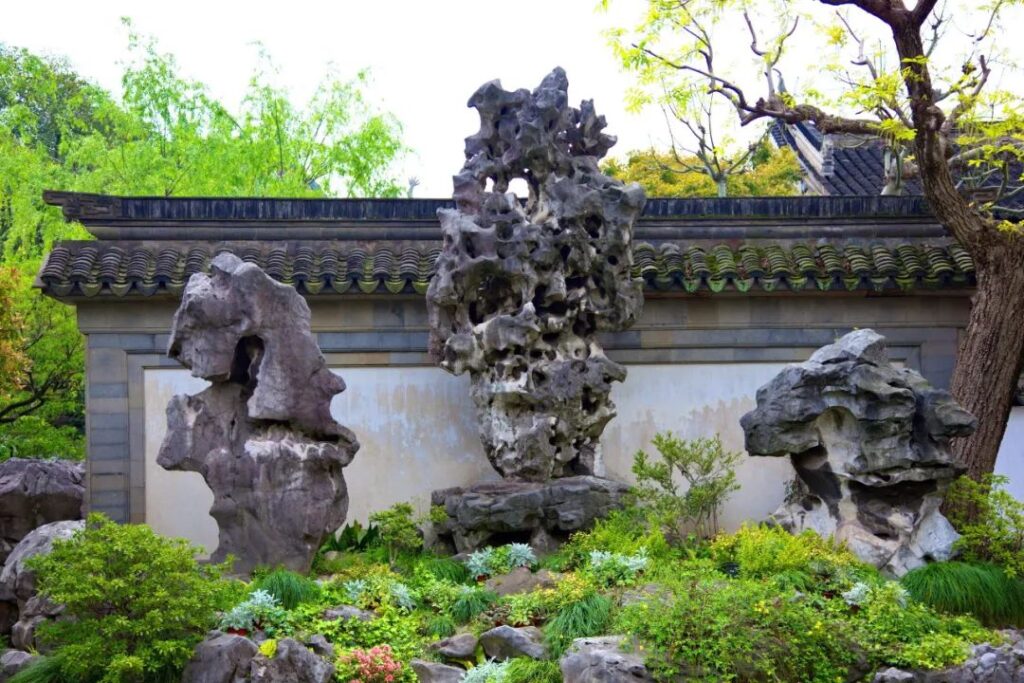
“Yulinglong” is the treasure of Yuyuan Garden. Along with the Guanyun Peak in Suzhou’s Liuyuan and the Zhouyun Peak in Hangzhou’s West Lake, it is known as one of the three famous rocks in Jiangnan. Legend has it that it is a relic of the “Huashigang” from the Song Dynasty.
It possesses the beauty of wrinkles, holes, thinness, and transparency, making it a masterpiece among rocks. The ancients said, “Place an incense burner at the bottom of the rock, and smoke will come out from every hole; pour a bowl of water on top of the rock, and springs will flow from every hole.”
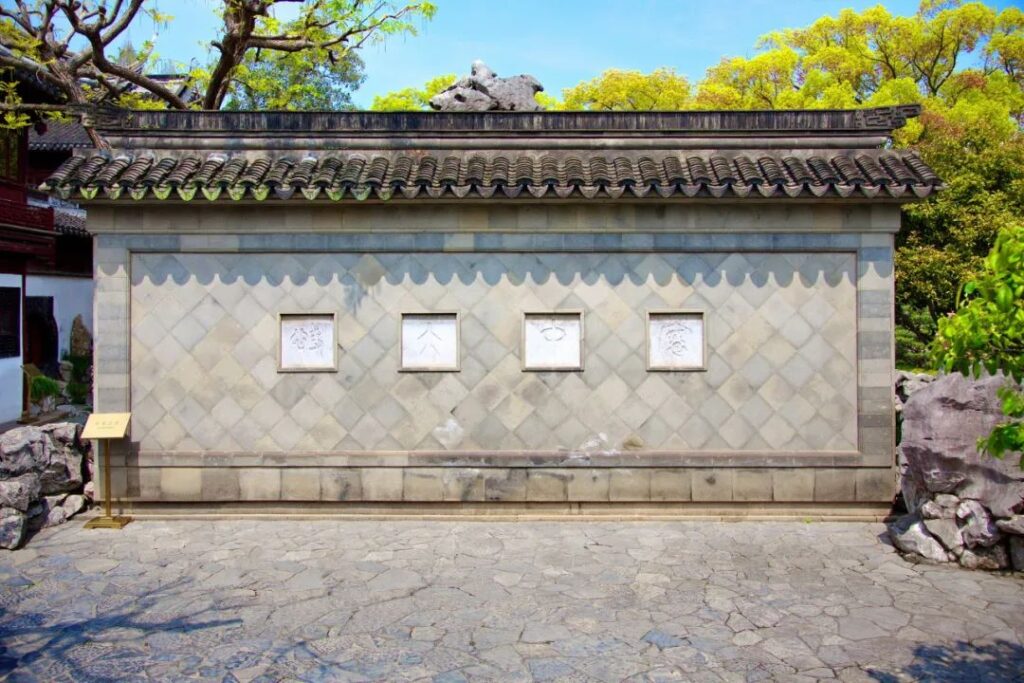
Behind Yulinglong, there is a screen wall used to set off this unique rock. On the back of the screen wall, four seal script characters “Huan Zhong Da Kuai” are embedded. “Huan Zhong” generally refers to “the universe” or “the world,” and “Huan Zhong Da Kuai” means “great joy in the world.”
There is a pond in front of Yulinglong, with rocks on both sides and a screen wall behind. Therefore, it is said that there are three elements in Yuyuan Garden that set off Yulinglong: rocks set off by rocks, rocks set off by water, and rocks set off by walls.
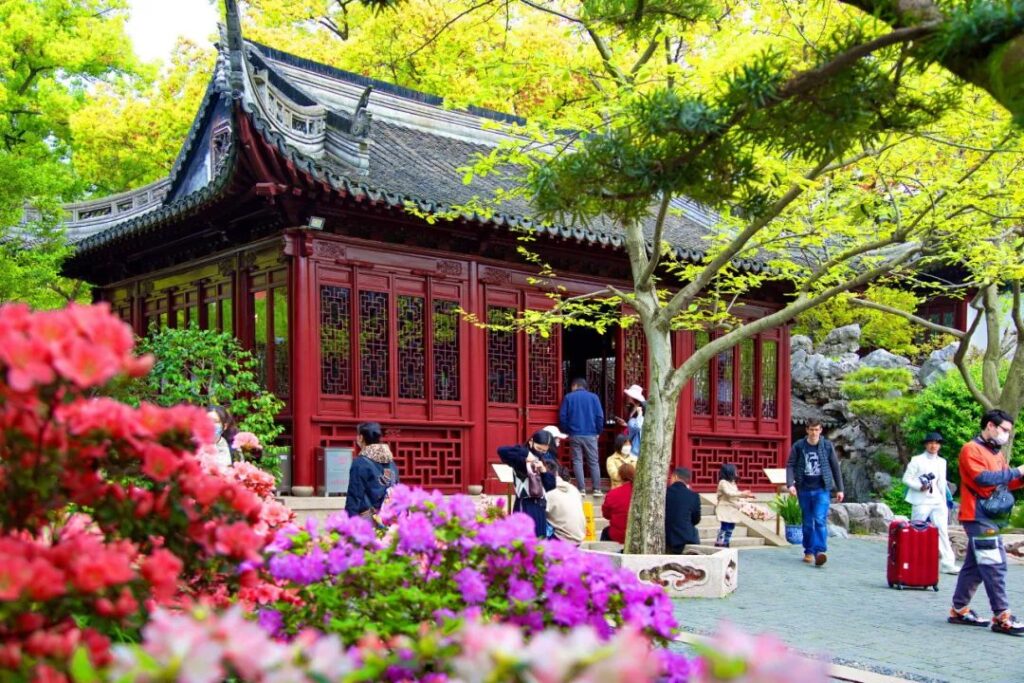
“Yuhua Hall” was the study of the garden owner Pan Yunduan. It is said that Pan Yunduan loved rocks. In order to appreciate the unique Yulinglong rock, he specifically built this study in front of the rock and named it Yuhua Hall after the two characters “Yuhua” on the Yulinglong rock.
The hall features a plaque with the characters “Yuhua Hall” written by the famous Ming Dynasty calligrapher Wen Zhengming. In front of Yuhua Hall, there are two white magnolia trees that are more than 130 years old.
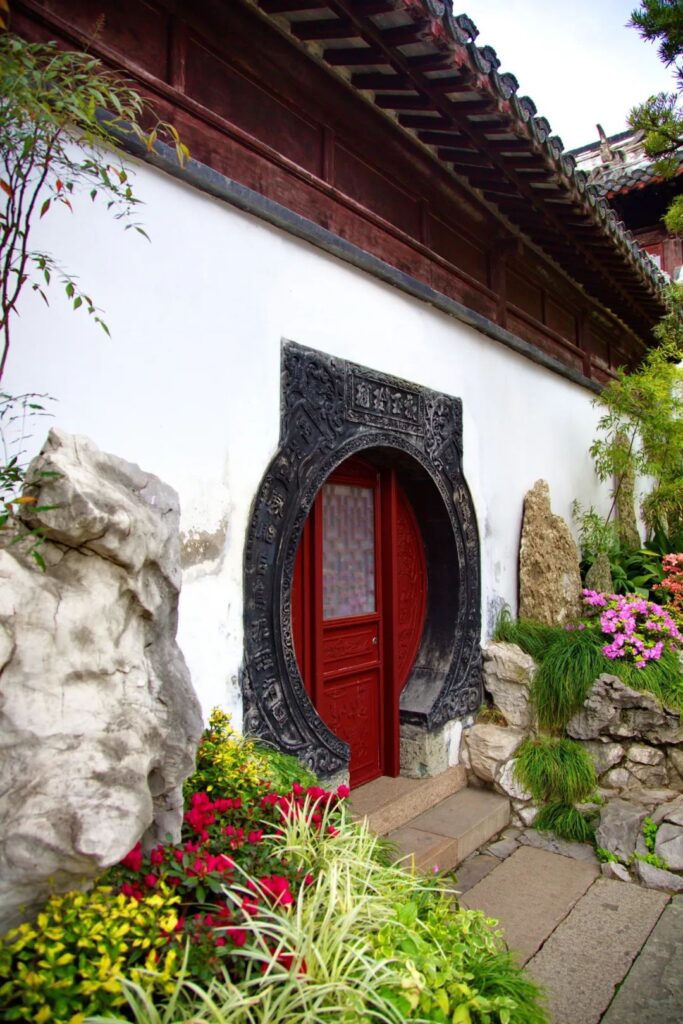
On the west side of Yulinglong, there is a circular cave gate with the inscription “Cheng Yu Ling Long” above it. Despite visiting Yuyuan Garden many times, I have never seen this gate open. It is said that entering the cave gate leads to a courtyard, with “Deyue Lou” on the north side and “Cangshu Lou” on the south side.
Deyue Lou is a two-story building with exquisite construction, painted beams, colorful pillars, winding corridors, and curved railings, both luxurious and tranquil.
Cangshu Lou, also known as the Painting and Calligraphy Building, was a place where many painters used to create art in the past and is the birthplace of the Shanghai School of Painting.
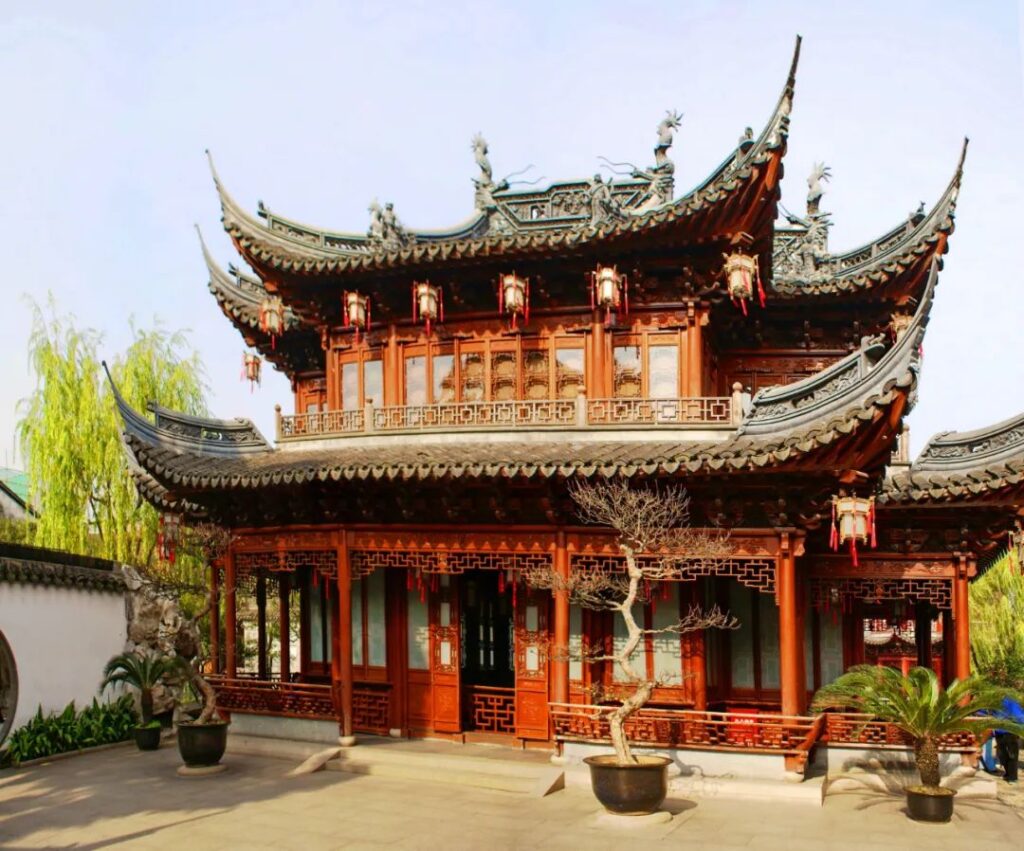
“Hanbi Lou” faces Tingtao Pavilion across the pond. The name “Hanbi” is derived from the poem “A body of water embraces the jade green, a thousand forests have already turned red” by the Song Dynasty neo-Confucian philosopher Zhu Xi. Hanbi Lou is a two-story building made entirely of Burmese rosewood.
The beams and arches are carved with one hundred kinds of flowers such as peonies, plum blossoms, lilies, narcissus, and roses, as well as forty full-page illustrations of the story “Romance of the Western Chamber.” Therefore, it is also called the “Rosewood Carved Flower Building.”
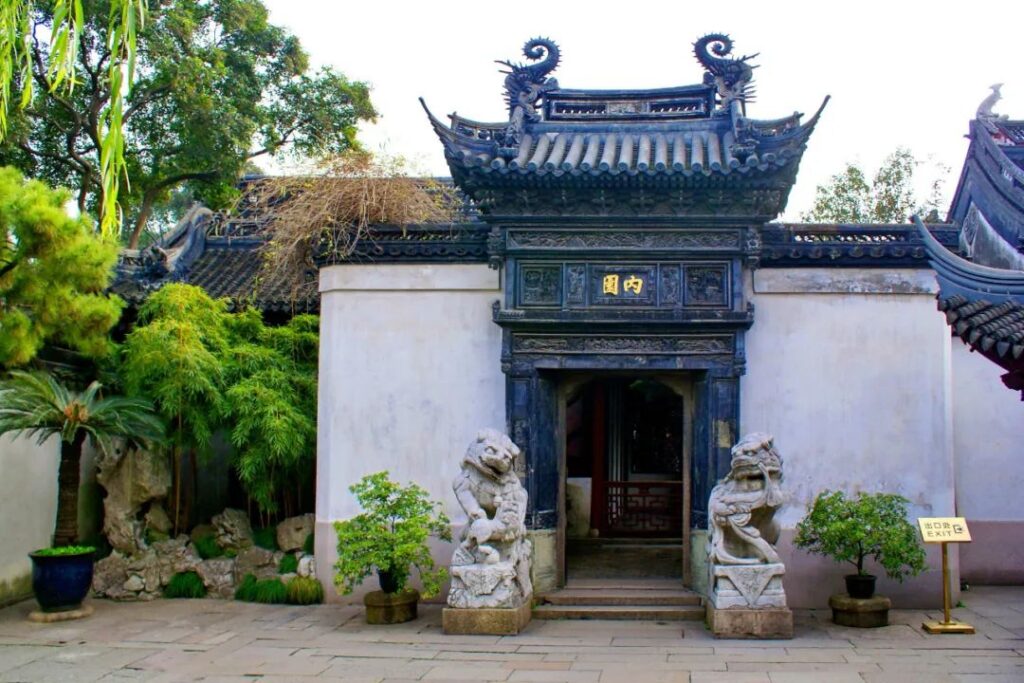
Passing through the Huan Long Bridge in front of the “Huan Zhong Da Kuai” screen wall, one reaches the gate tower of the inner garden scenic area in Yuyuan Garden. The inner garden originally had nothing to do with Yuyuan Garden.
During the Kangxi period of the Qing Dynasty, Shanghai gentry purchased land to build a temple garden for the City God Temple. However, due to the small size of the temple garden, the gentry pooled funds to purchase the long-abandoned Yuyuan Garden. In the late 1950s, during the renovation of Yuyuan Garden, the two gardens were connected, becoming a garden within a garden in Yuyuan.
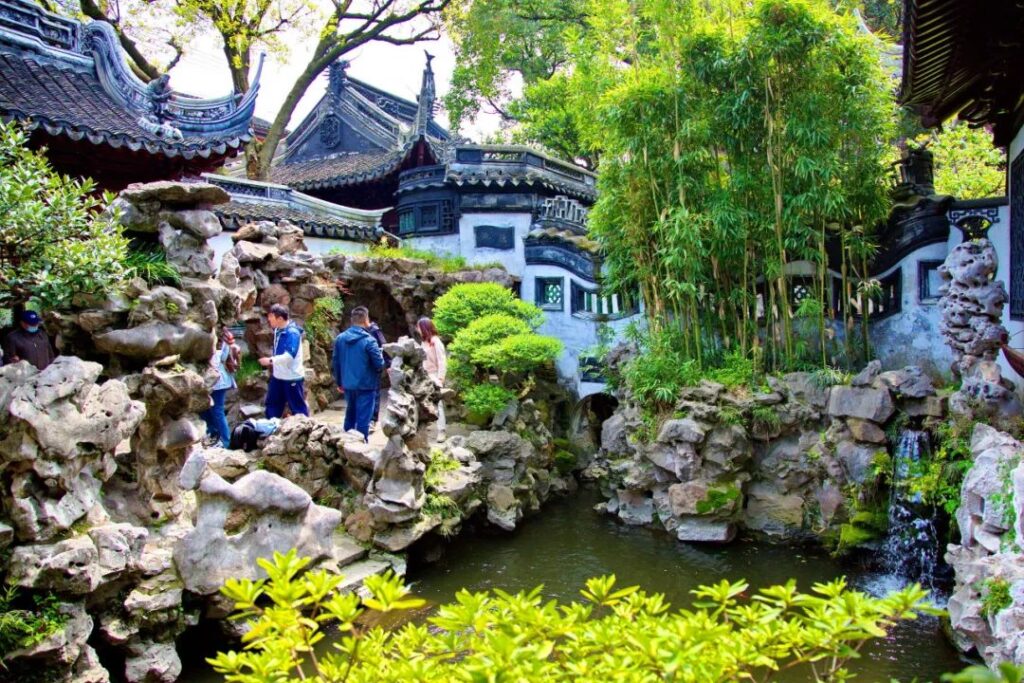
Although the inner garden is not large, with an area of only slightly over two mu (about 0.33 acres), it is very exquisite. The layout of the garden is compact, winding, and secluded, creating a tranquil and elegant atmosphere.
The towering rocks, meandering pond water, lush flowers and trees, halls and buildings, pavilions and towers, clay sculptures, brick carvings, rock peaks, and small bridges are all arranged in an orderly manner with distinct layers, making it one of the best-preserved small gardens from the Qing Dynasty in Shanghai.
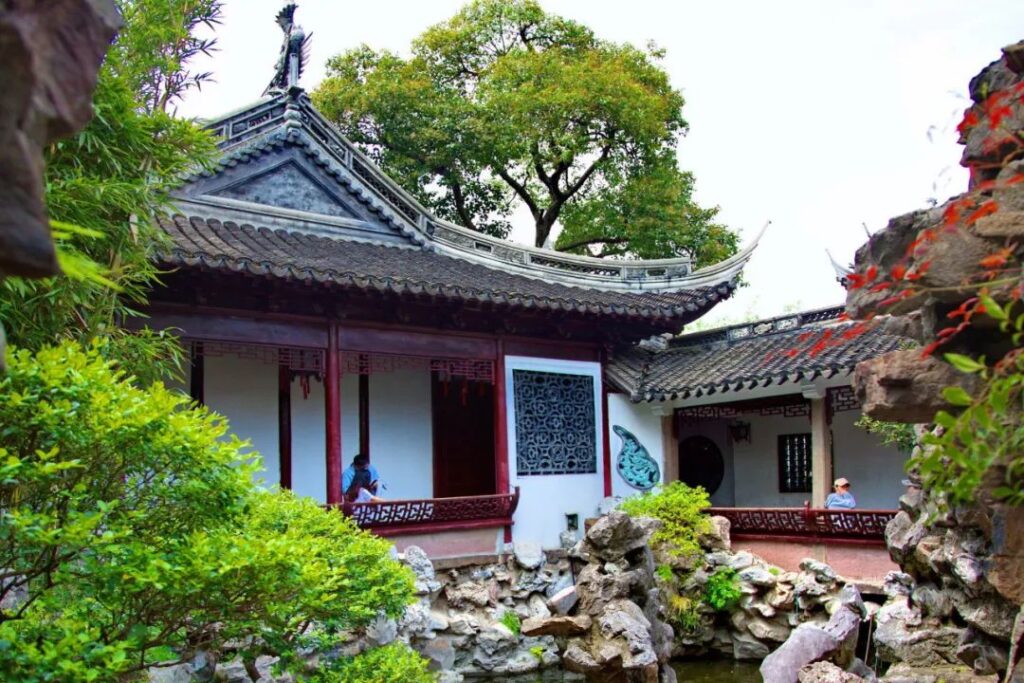
“Jingguan Hall” is the main hall of the inner garden, also known as “Qingxue Hall.” The name Jingguan is derived from the ancient saying “Quietly observing, all things are self-content” and the meaning of “Observing the flowing water in motion and the mountains in stillness.”
Opposite Jingguan Hall is a lifelike rockery, piled up in various postures with ancient trees standing tall. It is said that by quietly observing, one can discern many animal shapes, showing that the rockery opposite Jingguan Hall has a very meaningful ambiance.
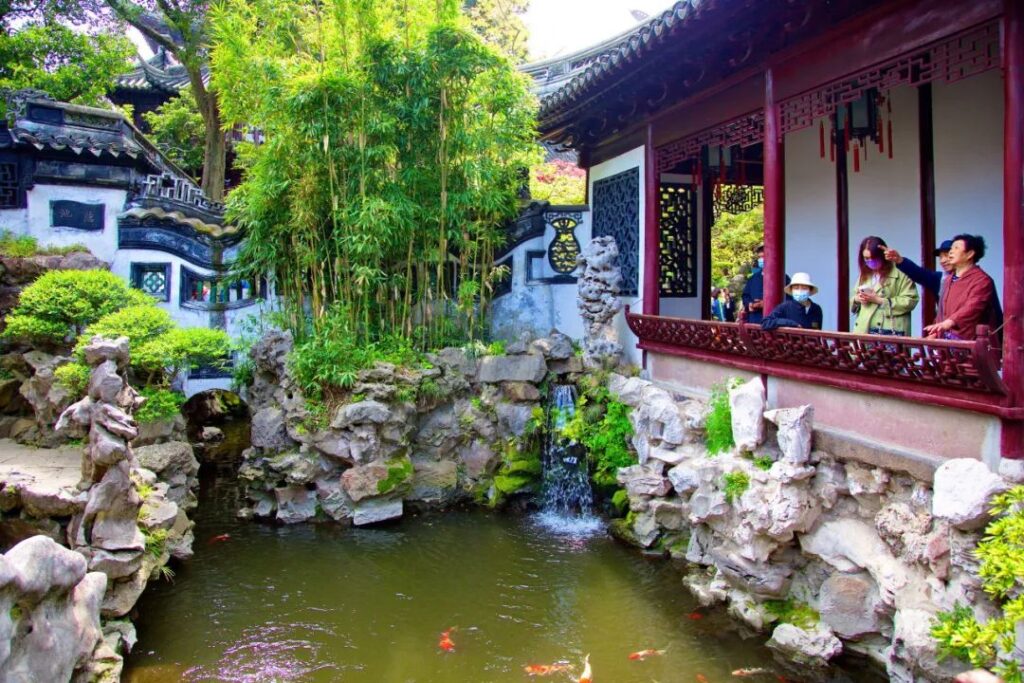
“Jiulong Pond” is a body of water built with Taihu rocks on the east side of Jingguan Hall. The shape of the pond resembles a dragon’s body, and hidden among the gaps in the east and west walls of the pond are four stone-carved dragon heads, with four dragon heads reflected in the water.
Winding corridors surround both sides of the pond, forming a small and exquisite courtyard together with the corridor pavilions and flower walls. The layout of the courtyard is compact, with trees providing shade from the sun and slender bamboo adding a touch of elegance, creating a deep and tranquil environment.
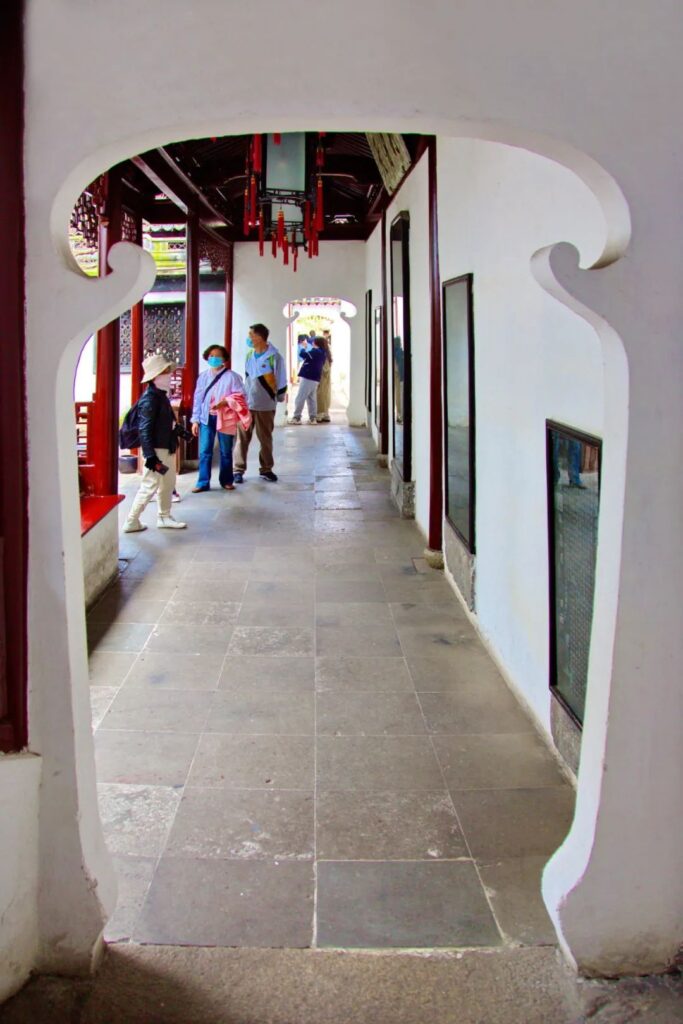
“Keyiguan” is a square small hall on the east side of Jingguan Hall. The small hall has relatively well-preserved the appearance of the early Qing Dynasty and is one of the top-ranked ancient wooden structures in Shanghai’s old town.
This square hall is exquisite and tranquil, especially cool in the scorching summer. In front of the hall, there is a brick carving of the “Guo Ziyi Birthday Celebration,” and inside the hall, there is a stone tablet recording the history of the inner garden’s renovation.

“Mian Long” (Sleeping Dragon) is located between Keyiguan and Songcui Pavilion. It is the only sleeping dragon among the five dragons on the dragon wall of Yuyuan Garden. This sleeping dragon is different from the other four dragons.
The scales on the bodies of the other dragons are made of tiles and are in a horizontal position.
In contrast, the scales on the sleeping dragon’s body are made of clay and are in a downward position. Under the dragon’s mouth, there is a sculpted three-legged golden toad that seems to be drinking the dragon’s saliva.
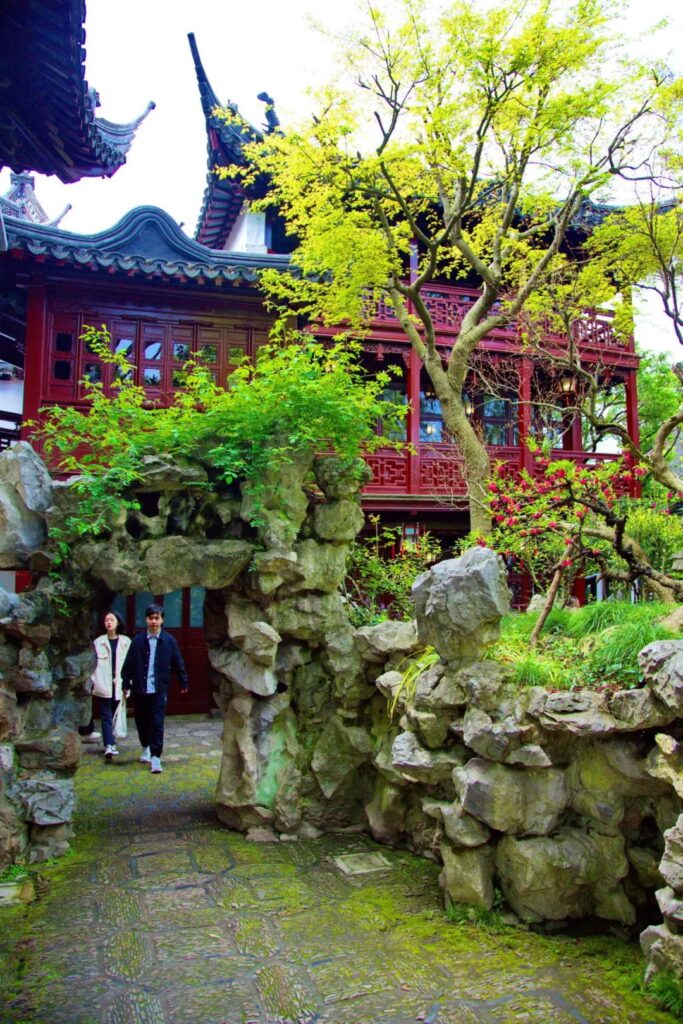
“Guantao Lou” (Wave-Watching Tower), also known as “Xiao Ling Tai” (Little Spiritual Platform), is a three-story all-wooden structure. The entire building was constructed without using a single iron nail, yet it is very sturdy.
During the Qing Dynasty, this building was the tallest in the eastern part of the city. Climbing to the top of this building and looking east, one could see the white sails dotting the Huangpu River and the surging waves, hence the name “Guantao Lou.”
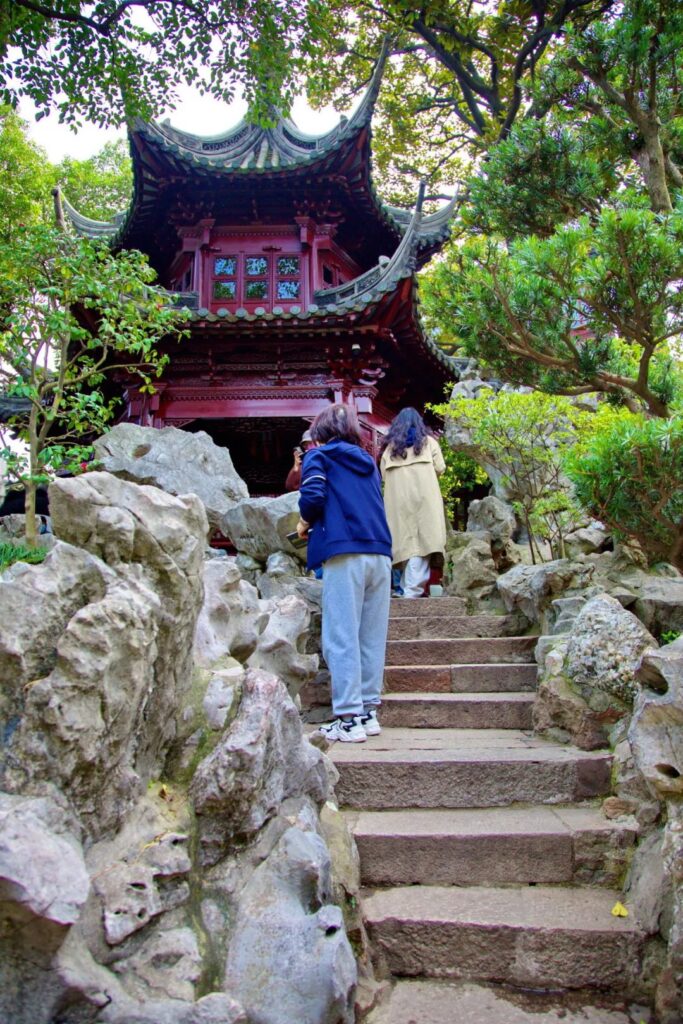
Following the stone steps, one can ascend to the lush rockery in the inner garden. The two-story “Songcui Pavilion” stands at the top of the rockery. Inside the pavilion, there are stone tables and benches for visitors to rest.
On the south side of Songcui Pavilion, there is a uniquely shaped boat. It is rare to see a boat built on top of a rockery.
The pebbles in front of the boat are arranged in a wave pattern, creating the illusion of the boat sailing on water, adding a unique ambiance.
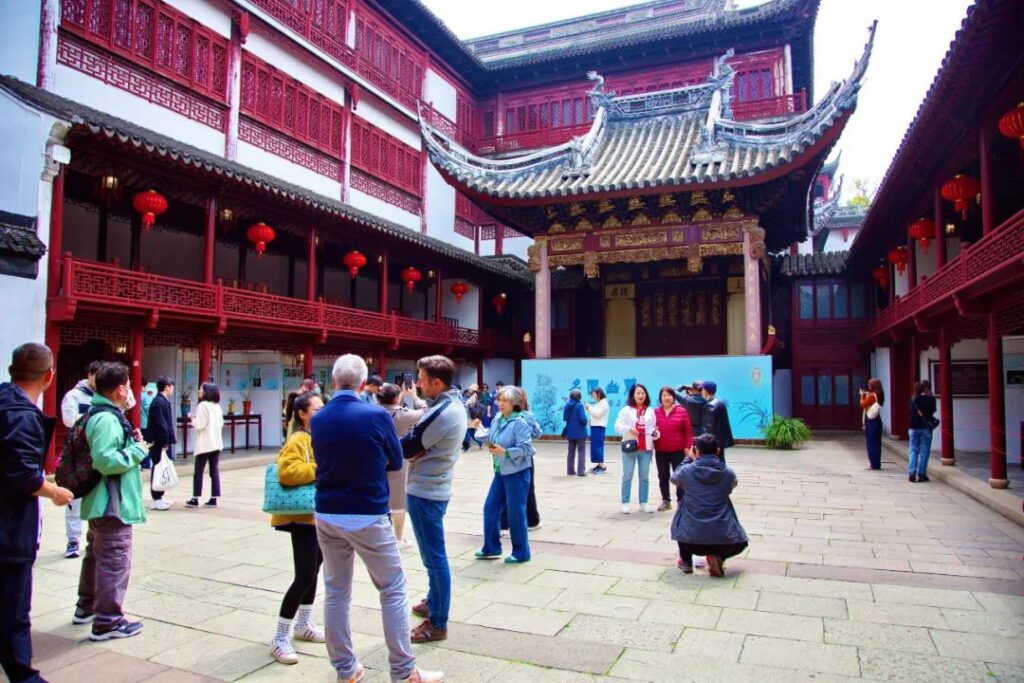
The ancient stage was built during the Guangxu period of the Qing Dynasty and is known as the “First Stage of Jiangnan Gardens.” The front of the stage is carved with lifelike images of double dragons playing with a pearl, opera characters, lions, phoenixes, and other patterns.
The top of the stage features a domed caisson, which not only serves as a beautiful decoration but also provides excellent acoustics.
On both sides of the stage, there are two-story viewing galleries, creating an elegant and ancient atmosphere.
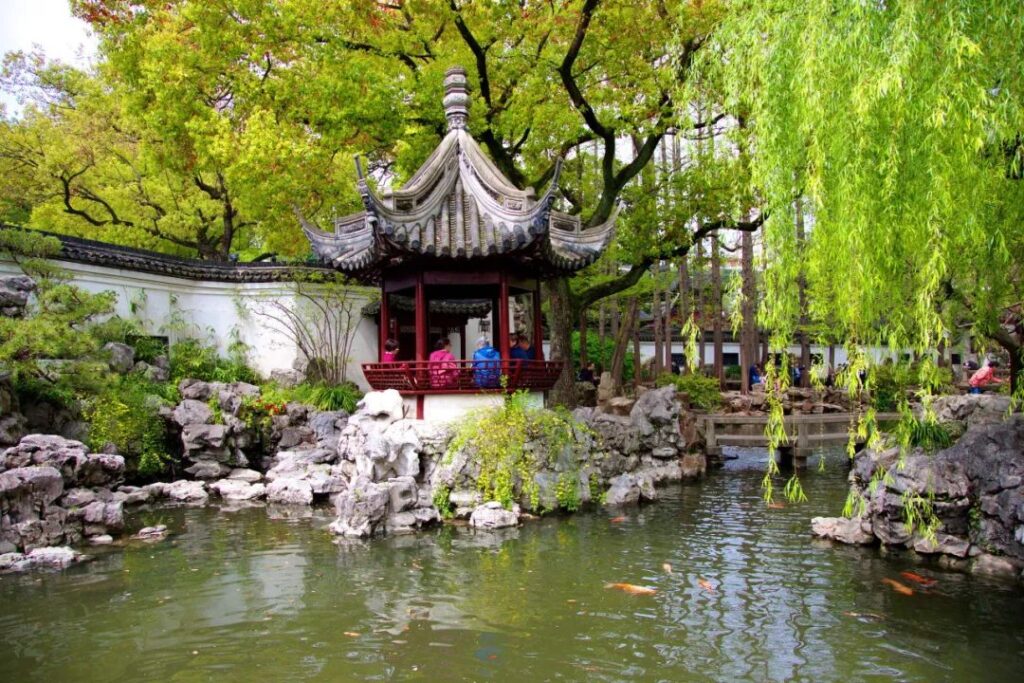
Walking along the corridors, passing through the rockeries, strolling along the winding paths, and climbing the buildings, I fully experienced the feeling of “a new scene with every step” in Yuyuan Garden.
The buildings, rockeries, ponds, rare flowers, and exotic trees constantly captivate my attention, making it difficult to take everything in.
Yuyuan Garden truly lives up to its reputation as the most beautiful garden in Jiangnan.

